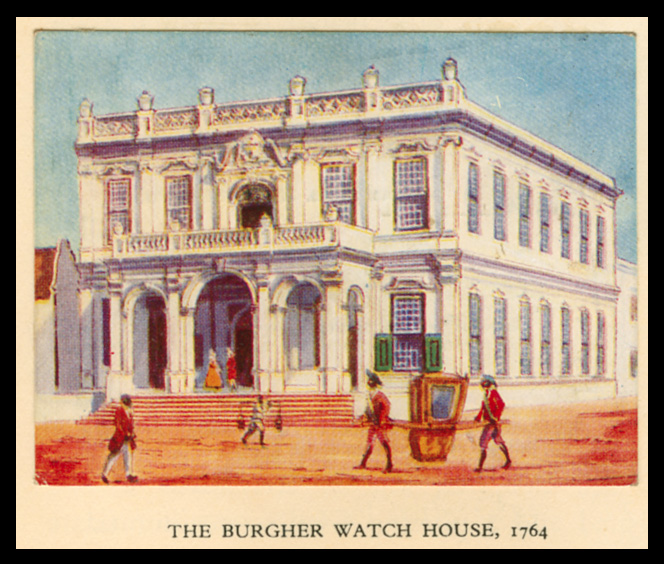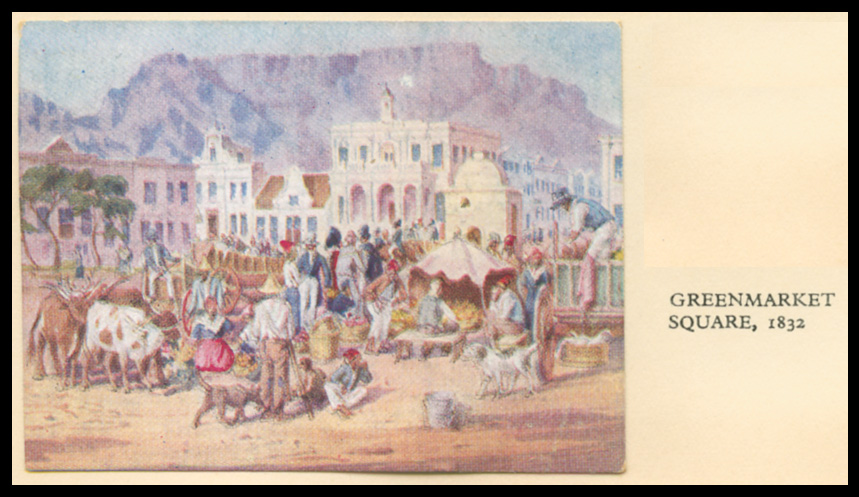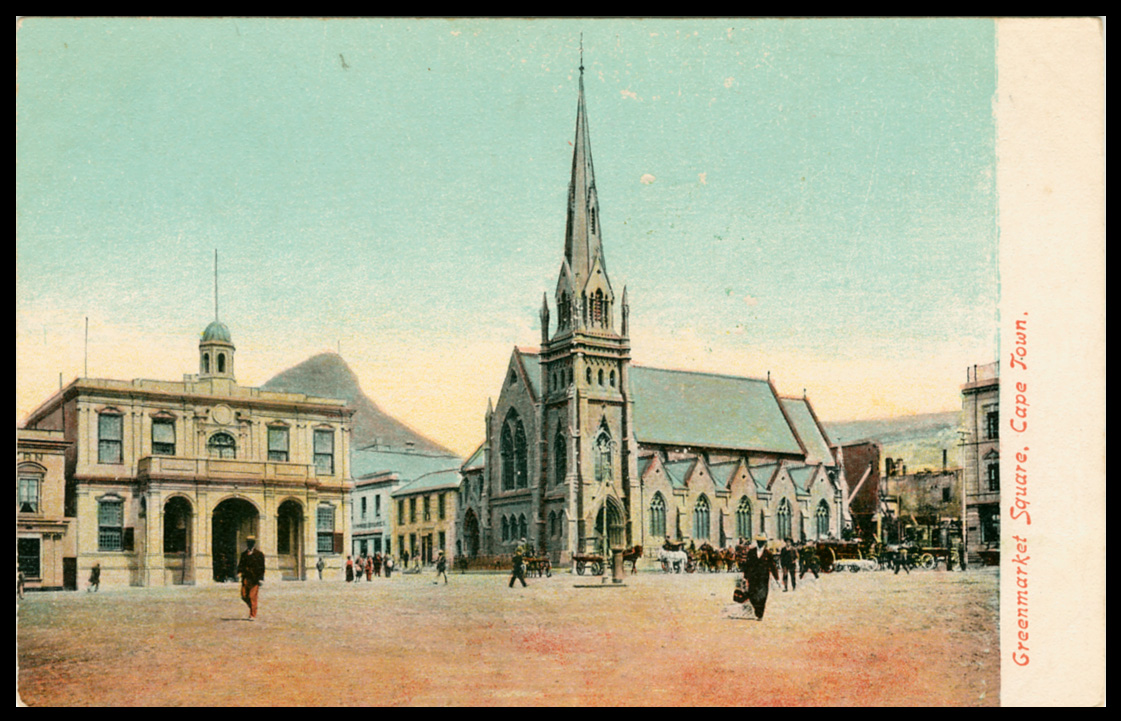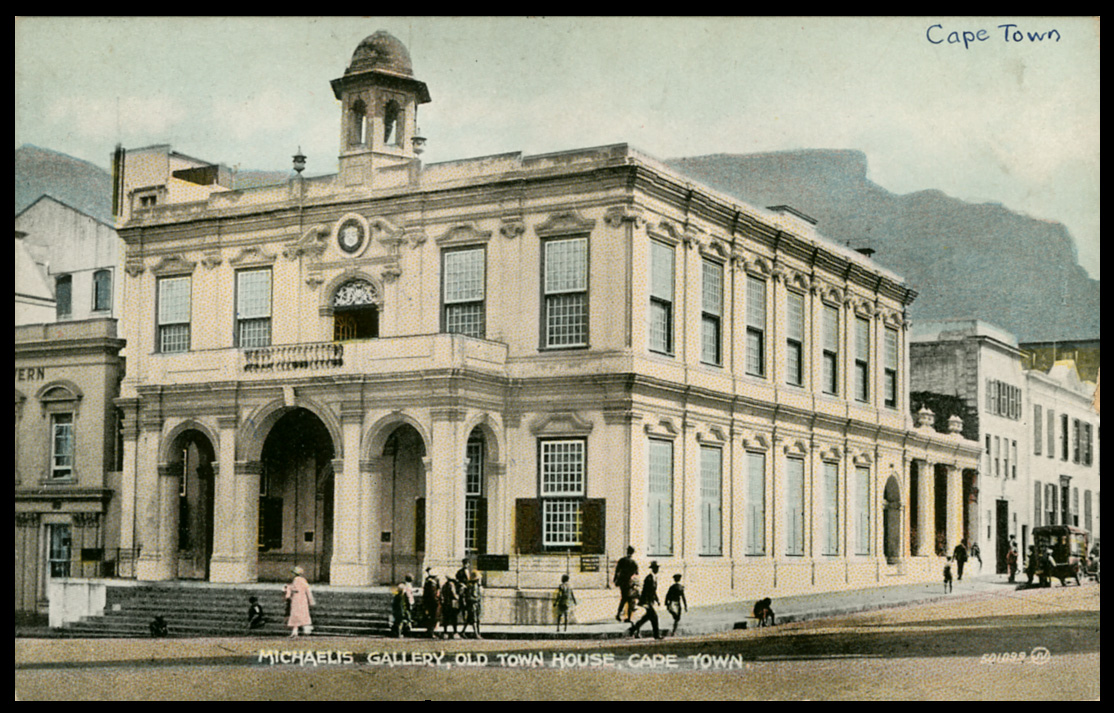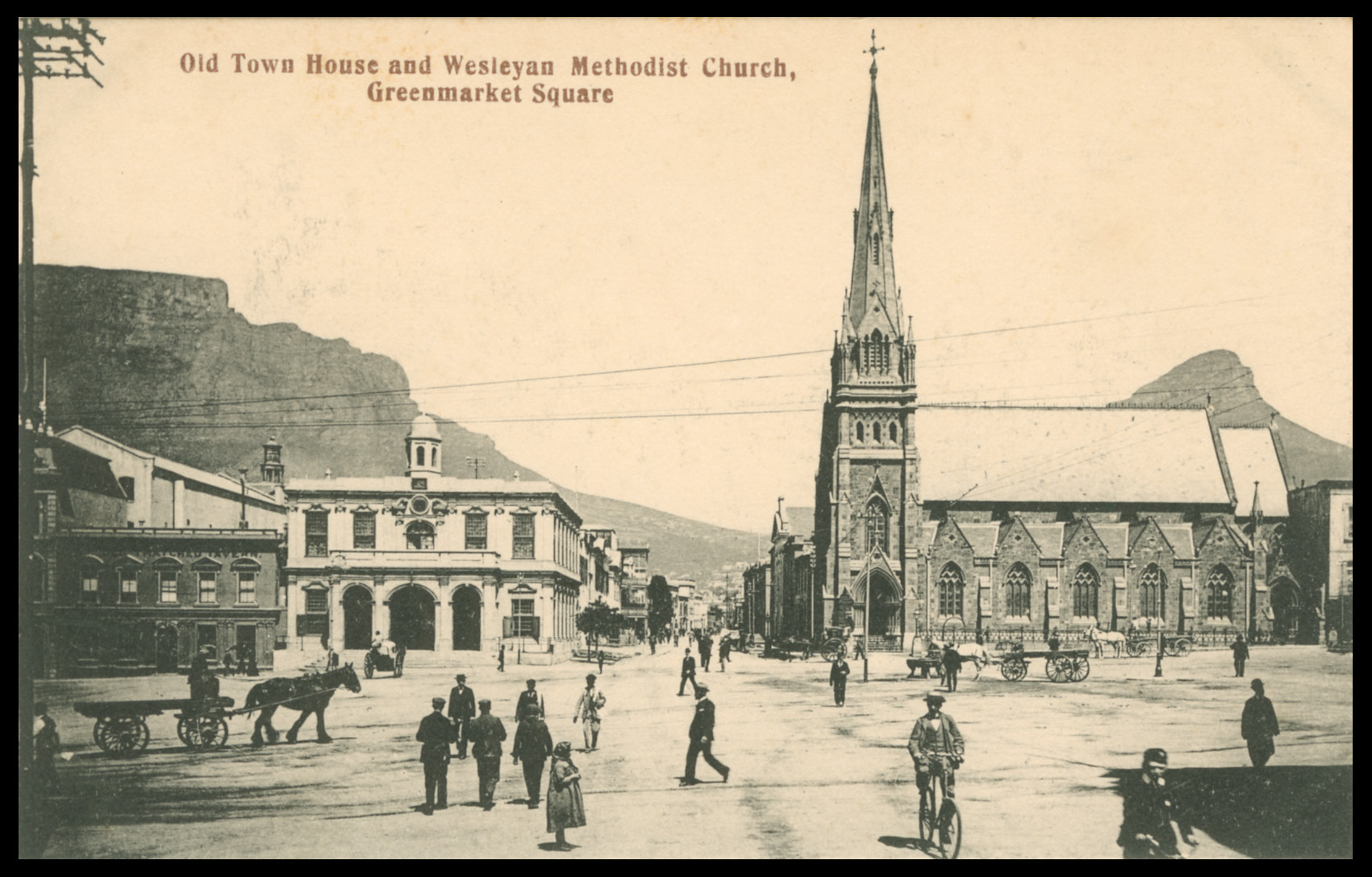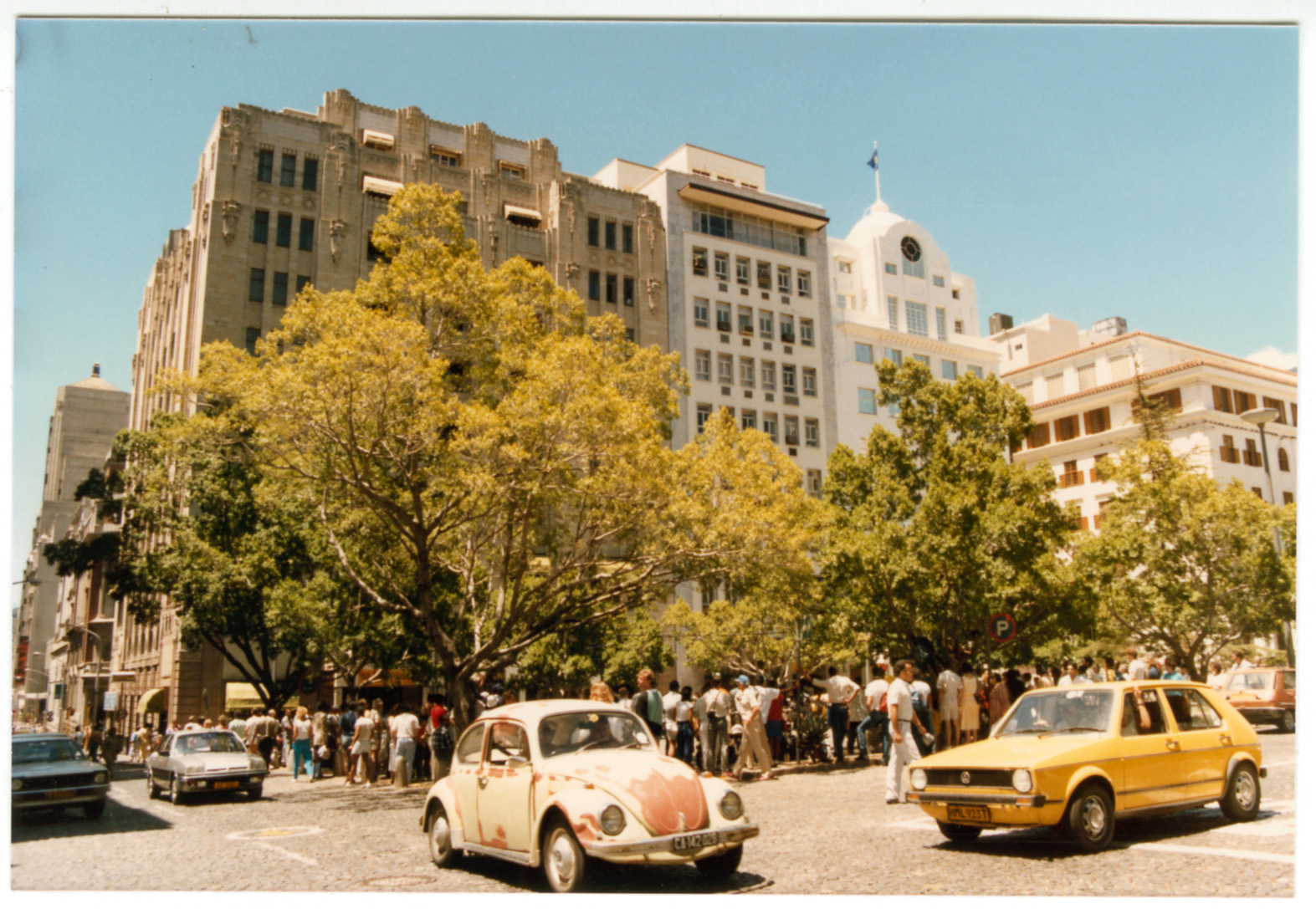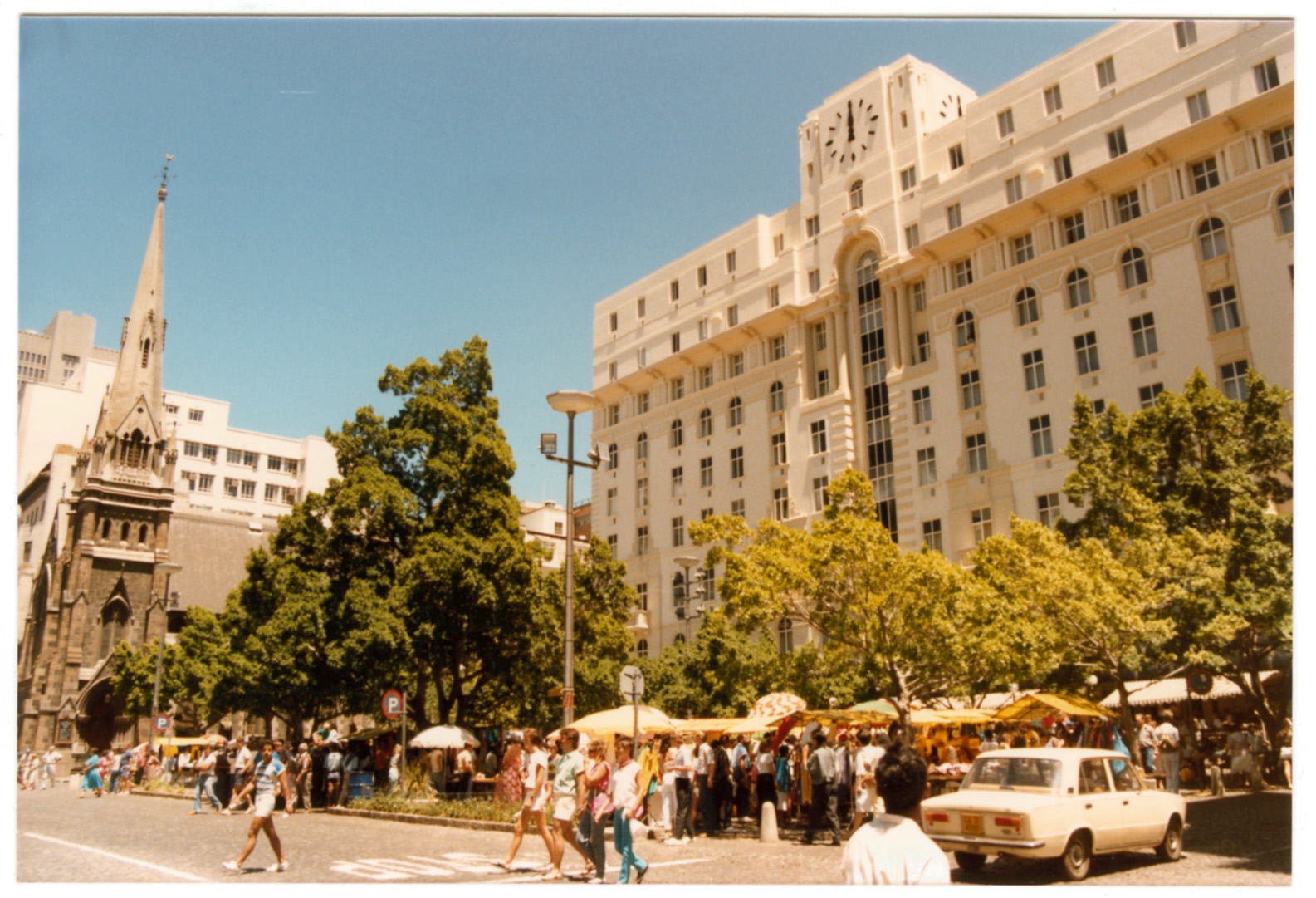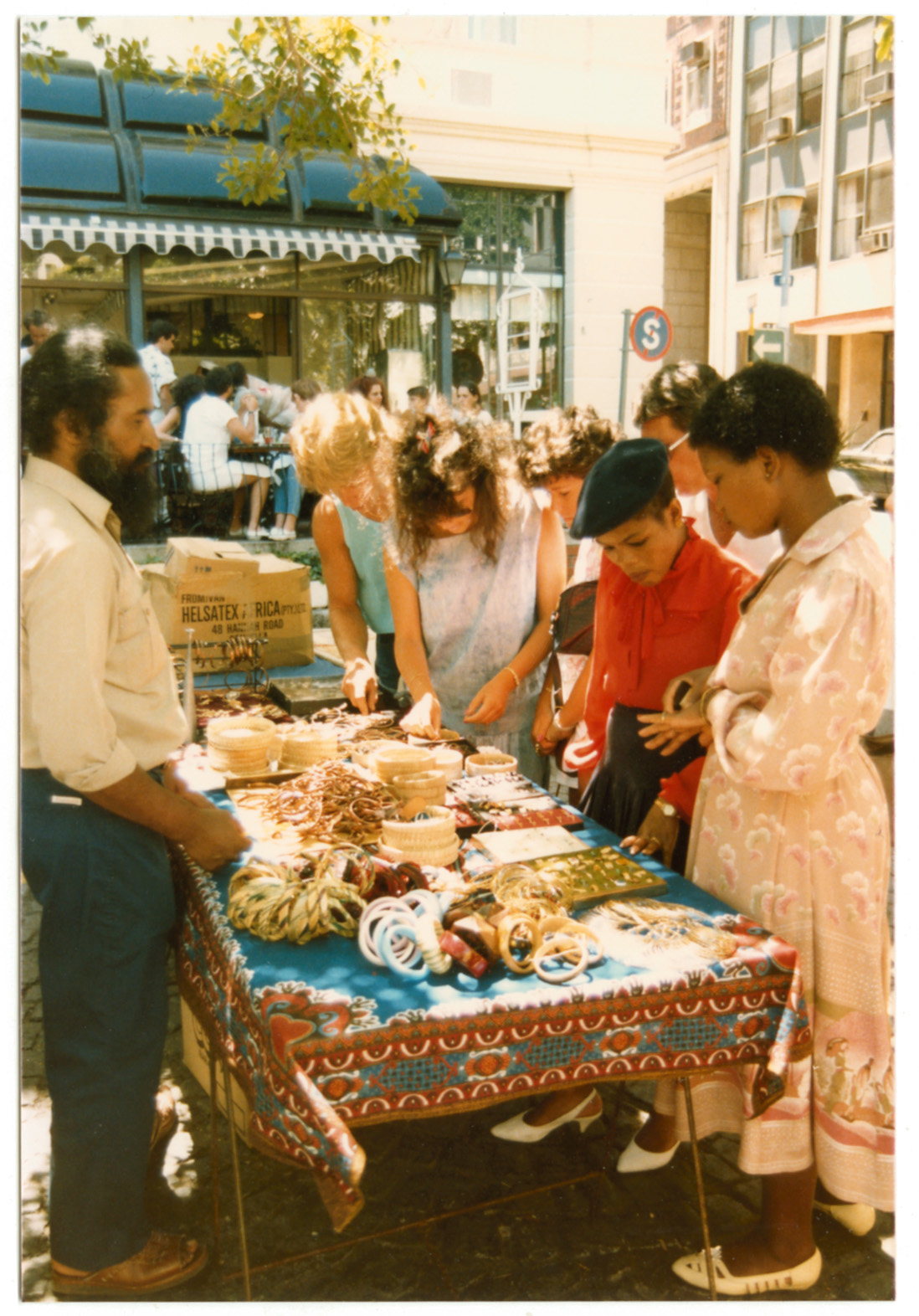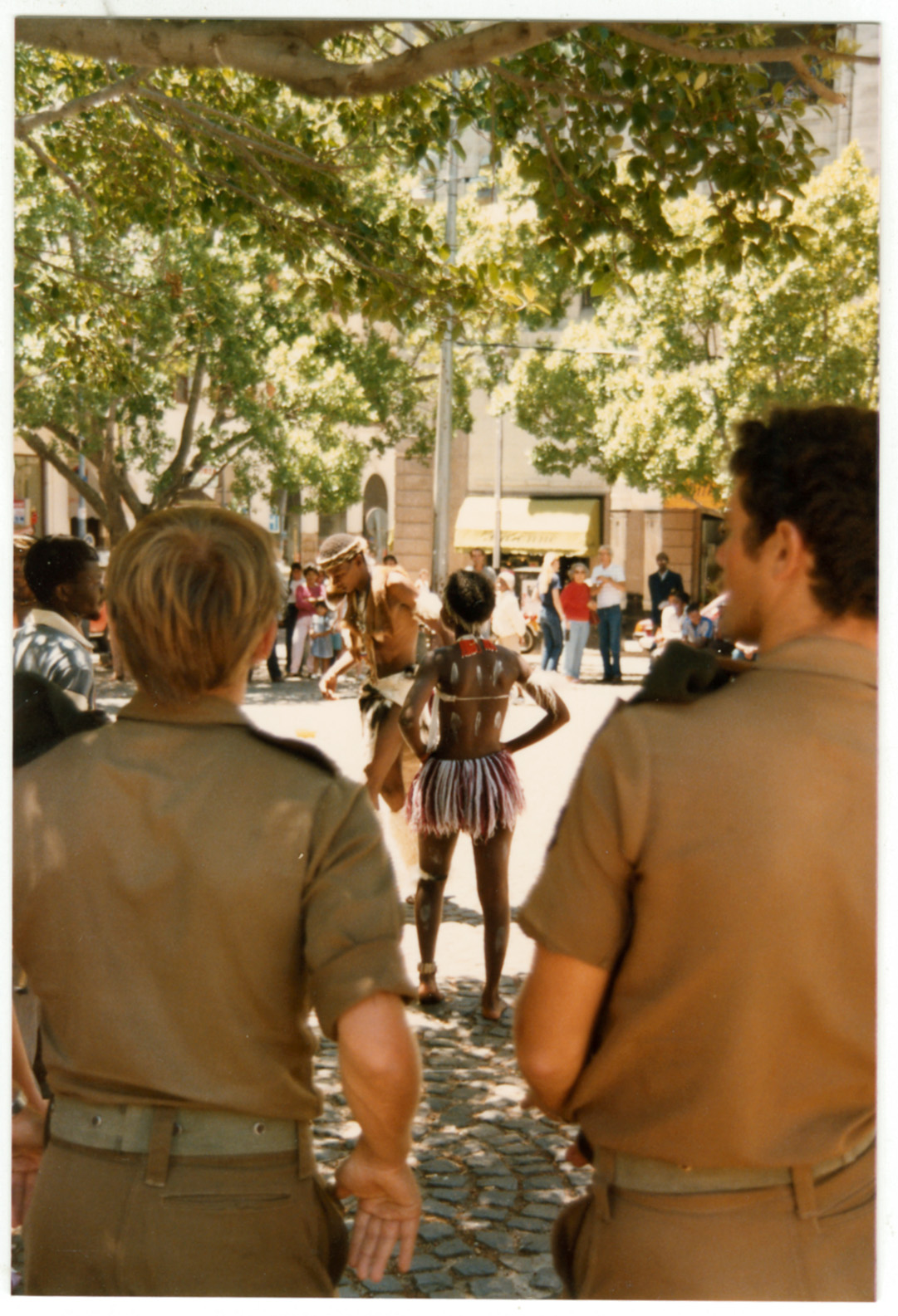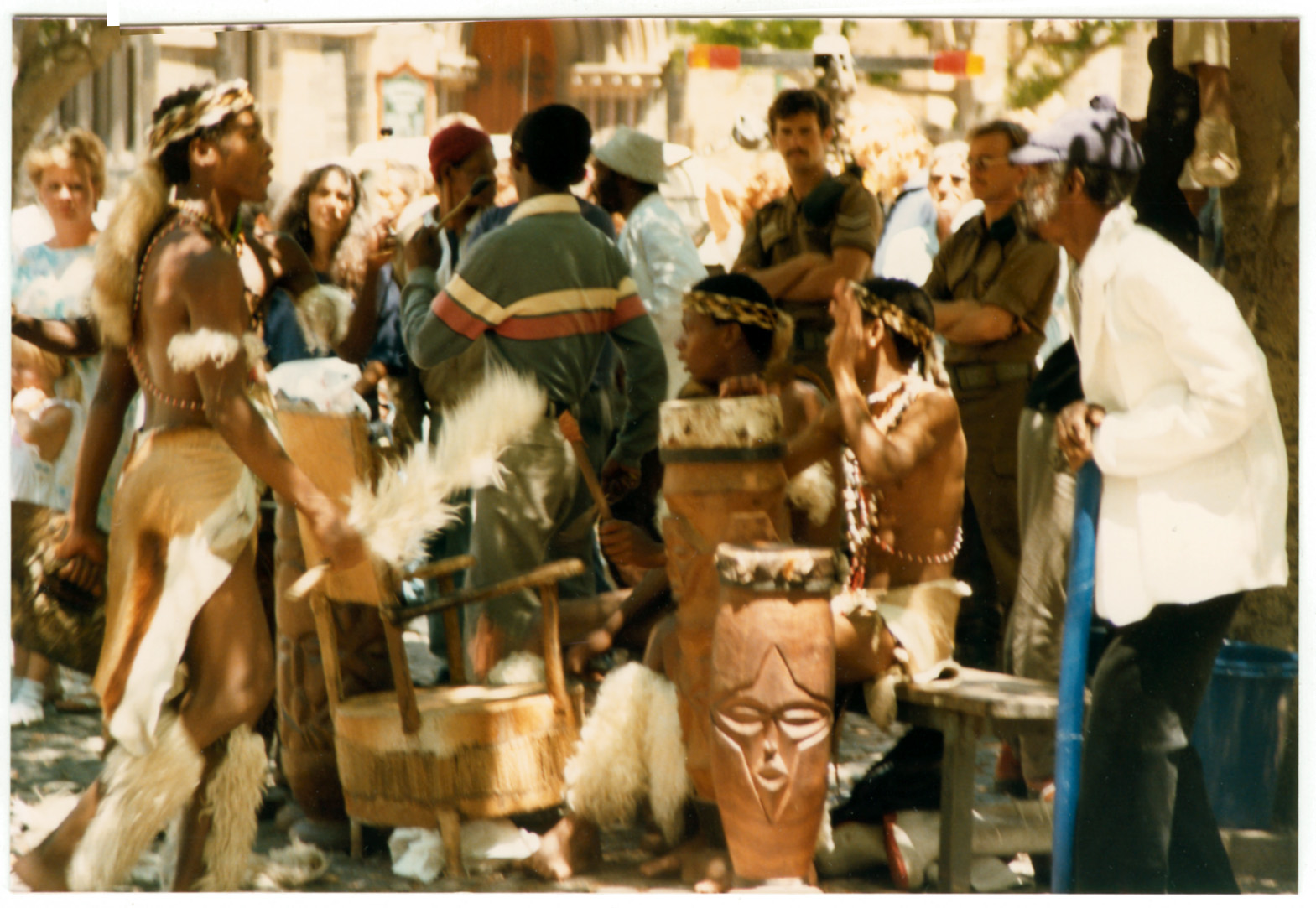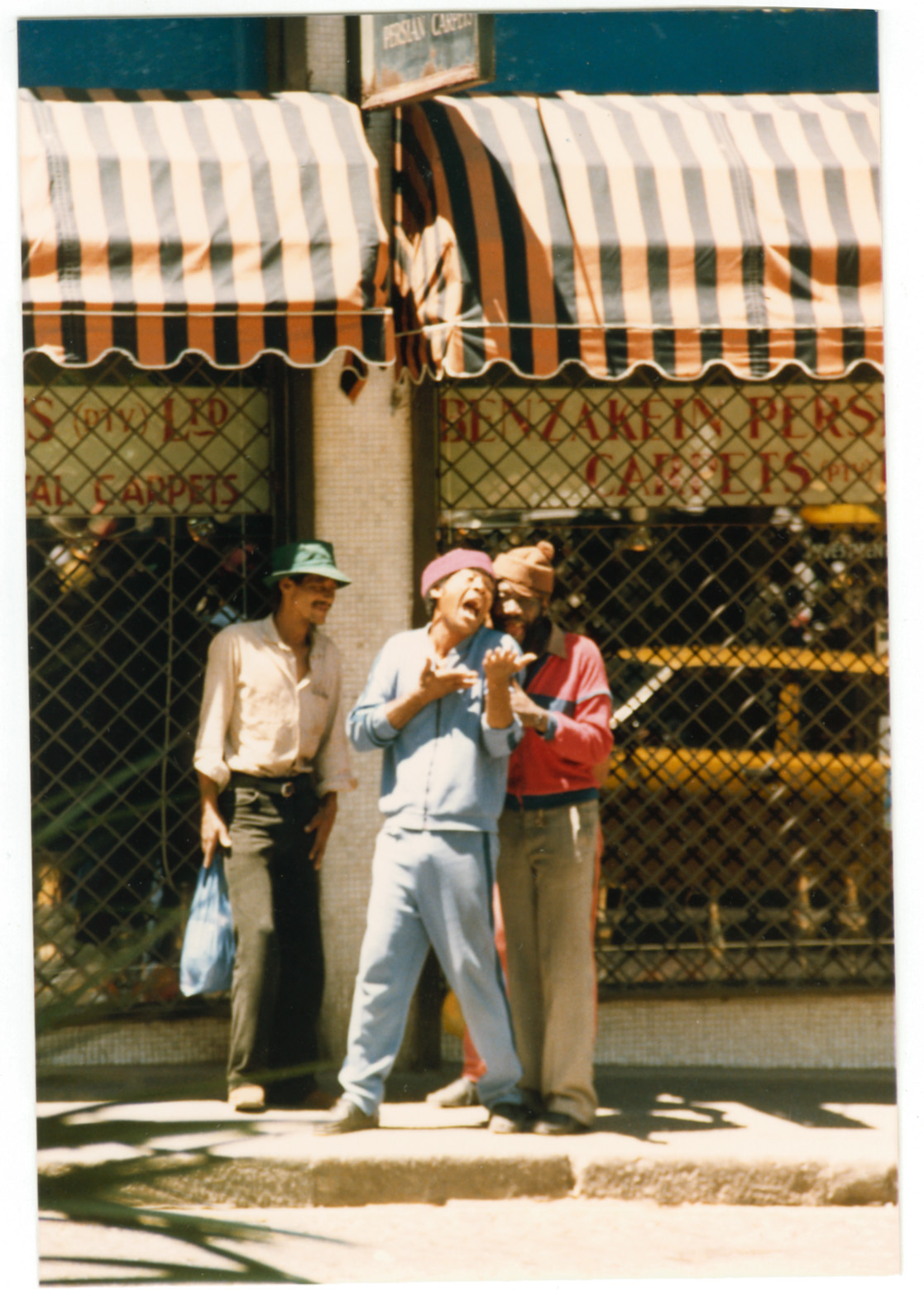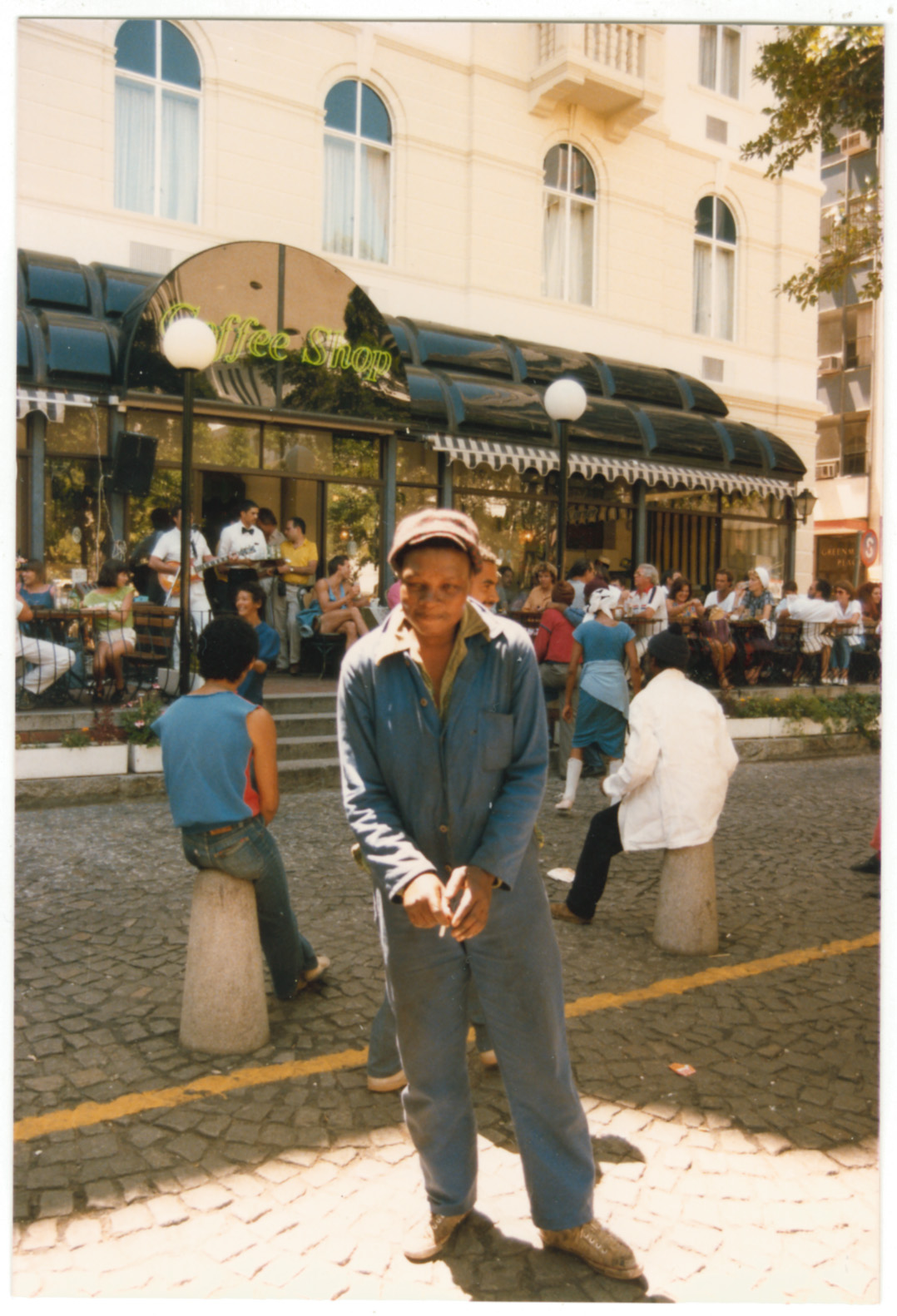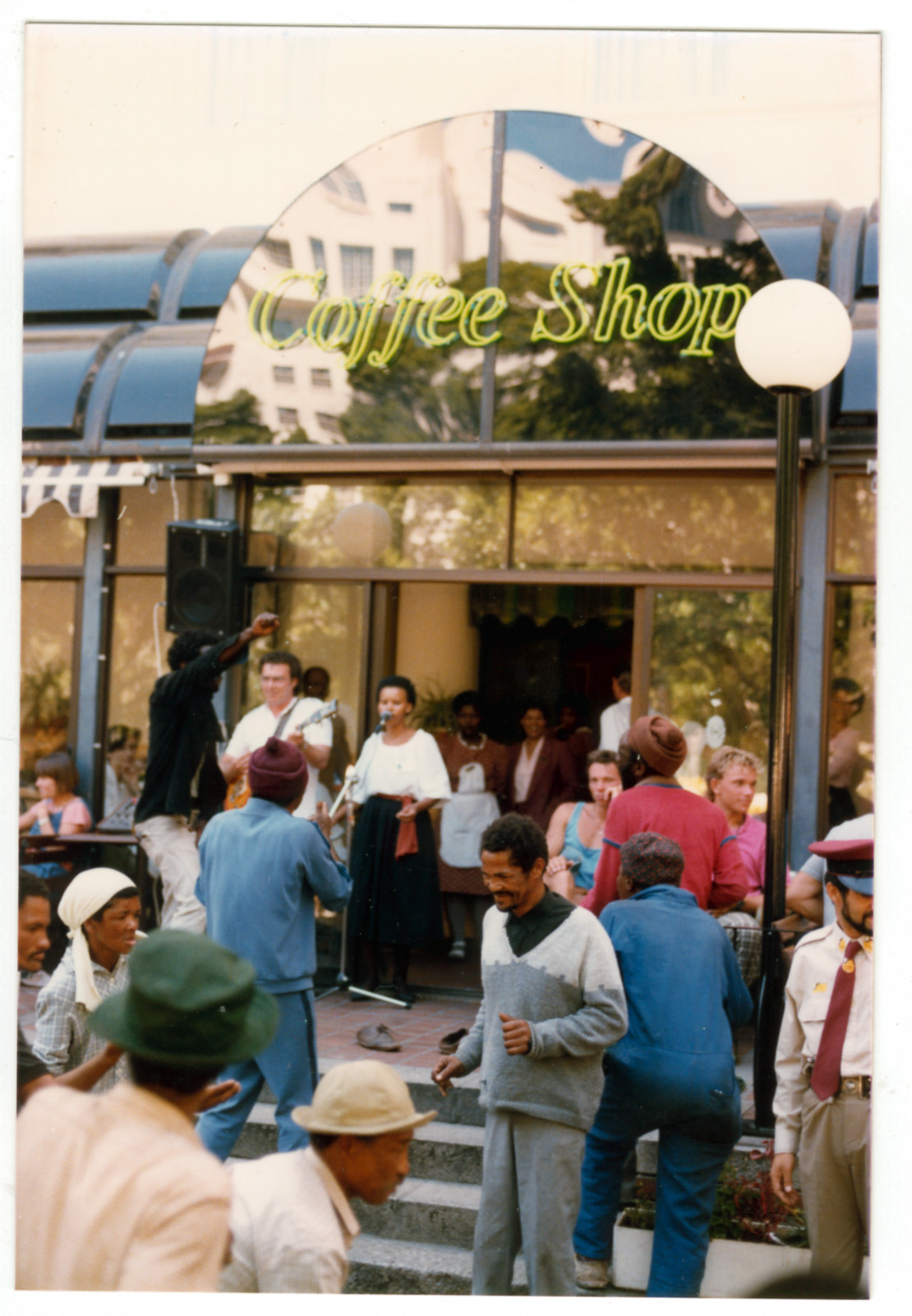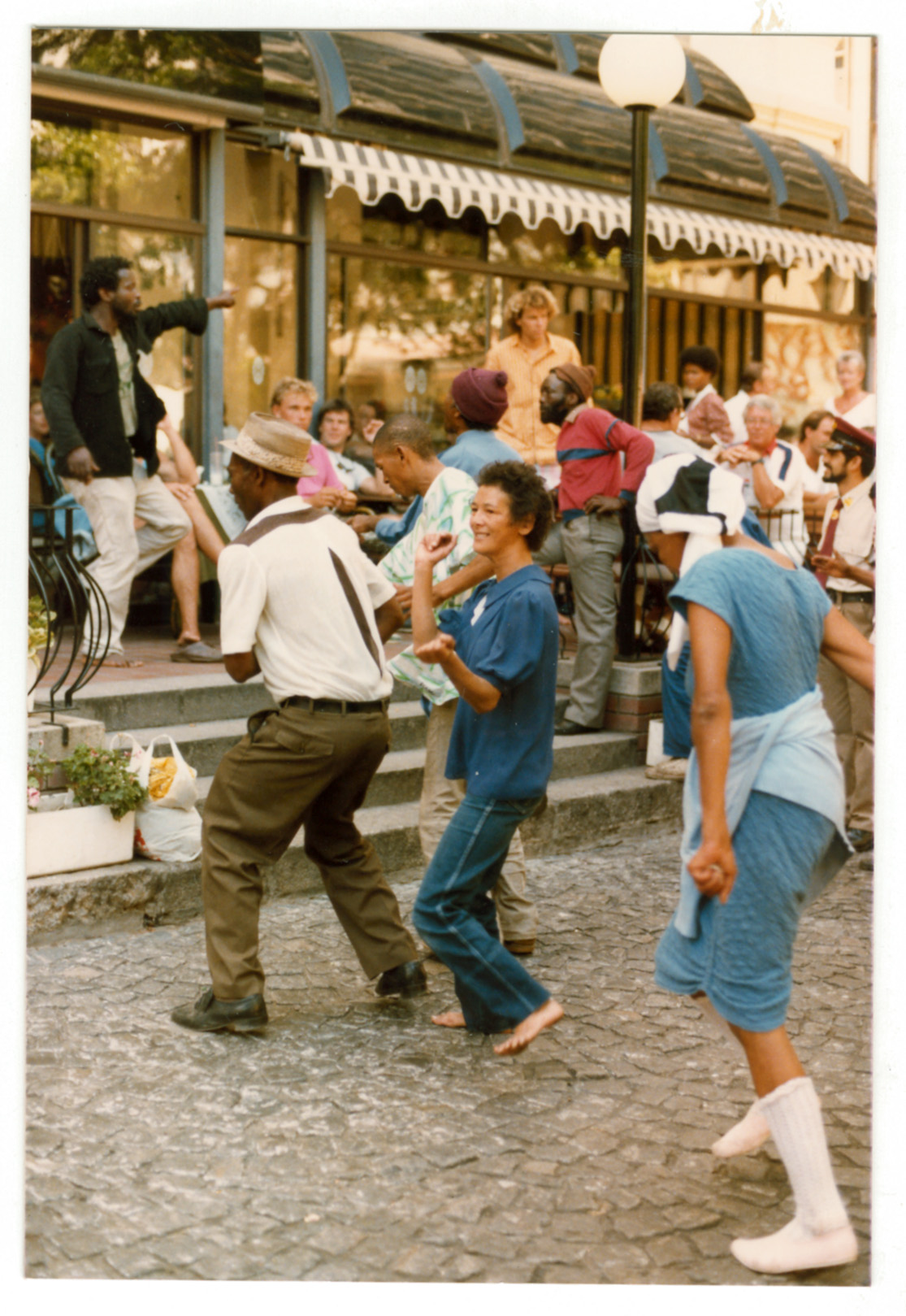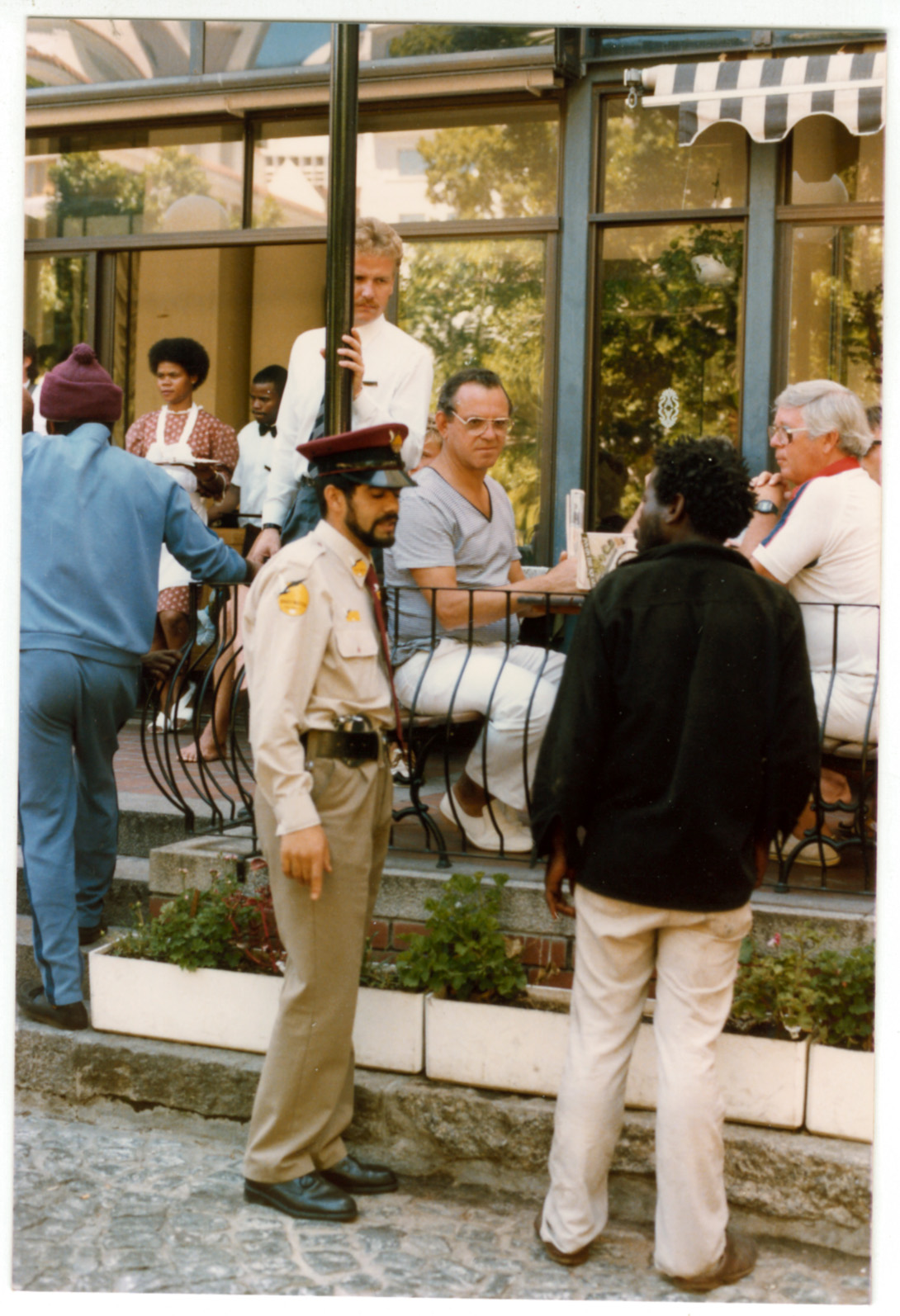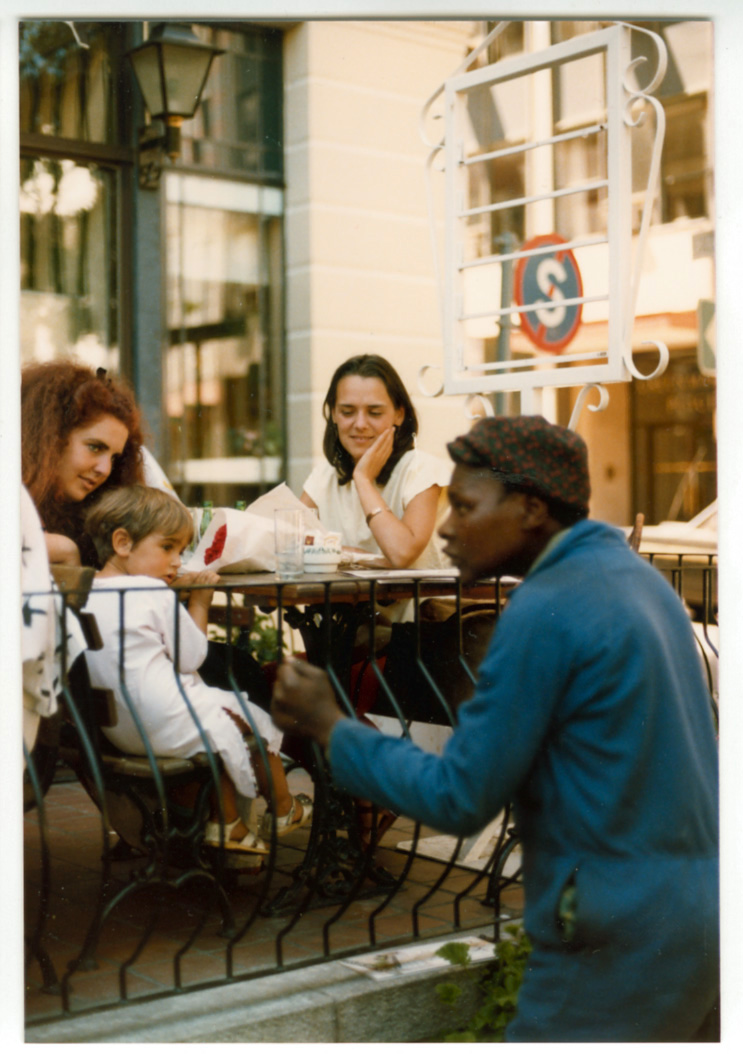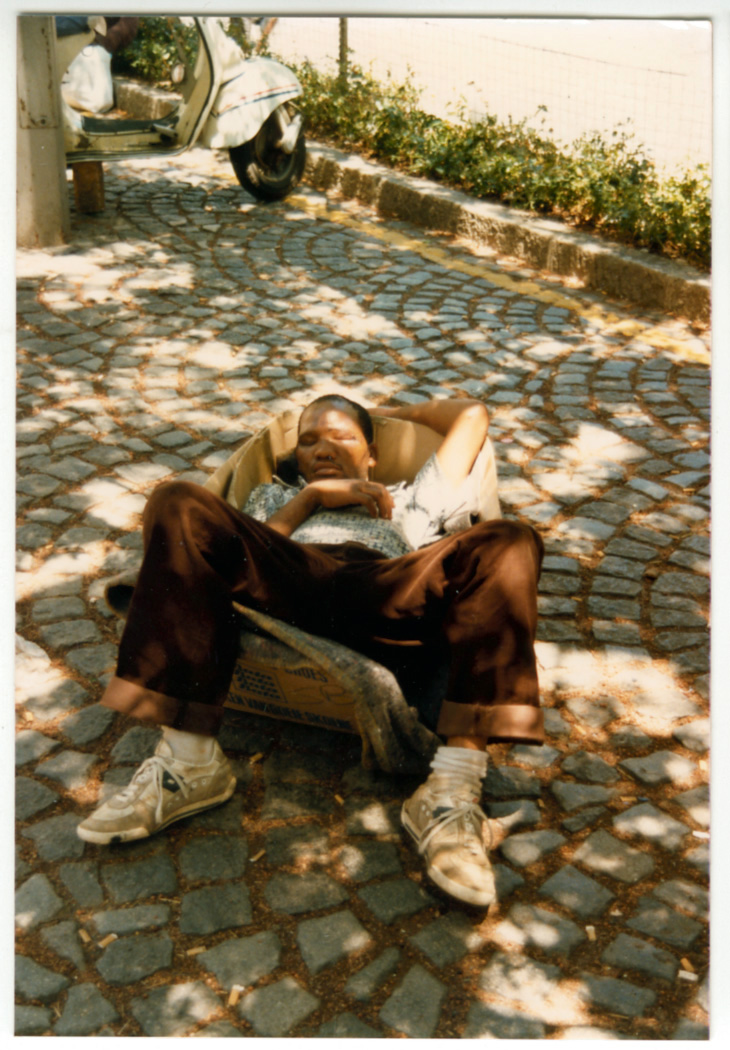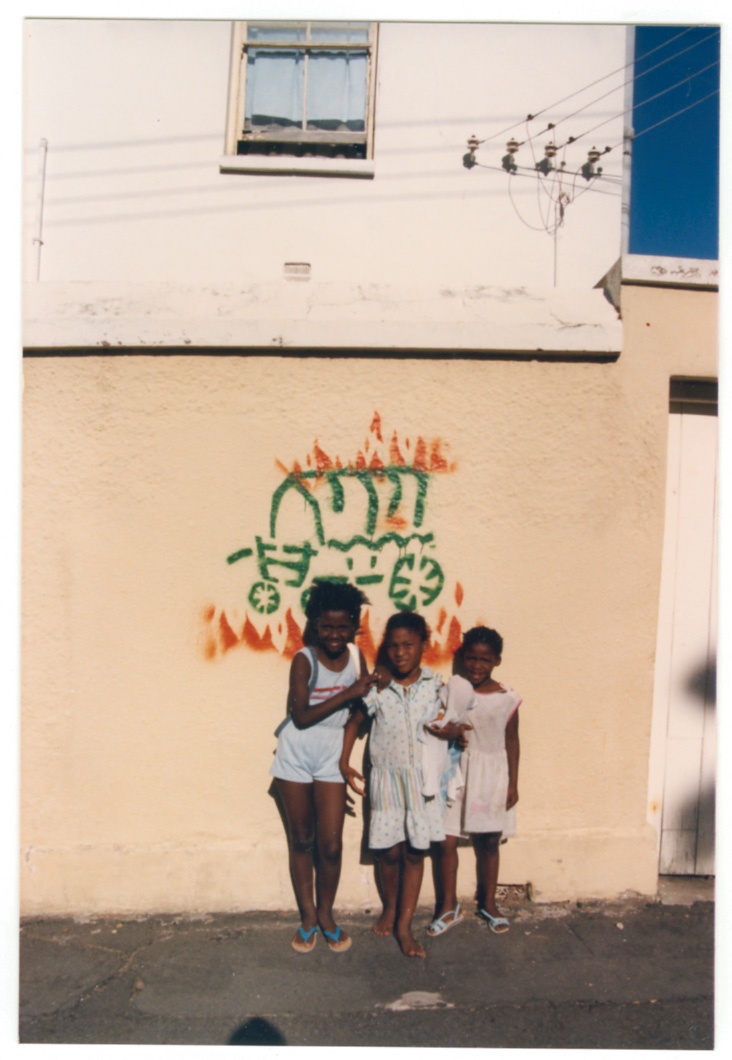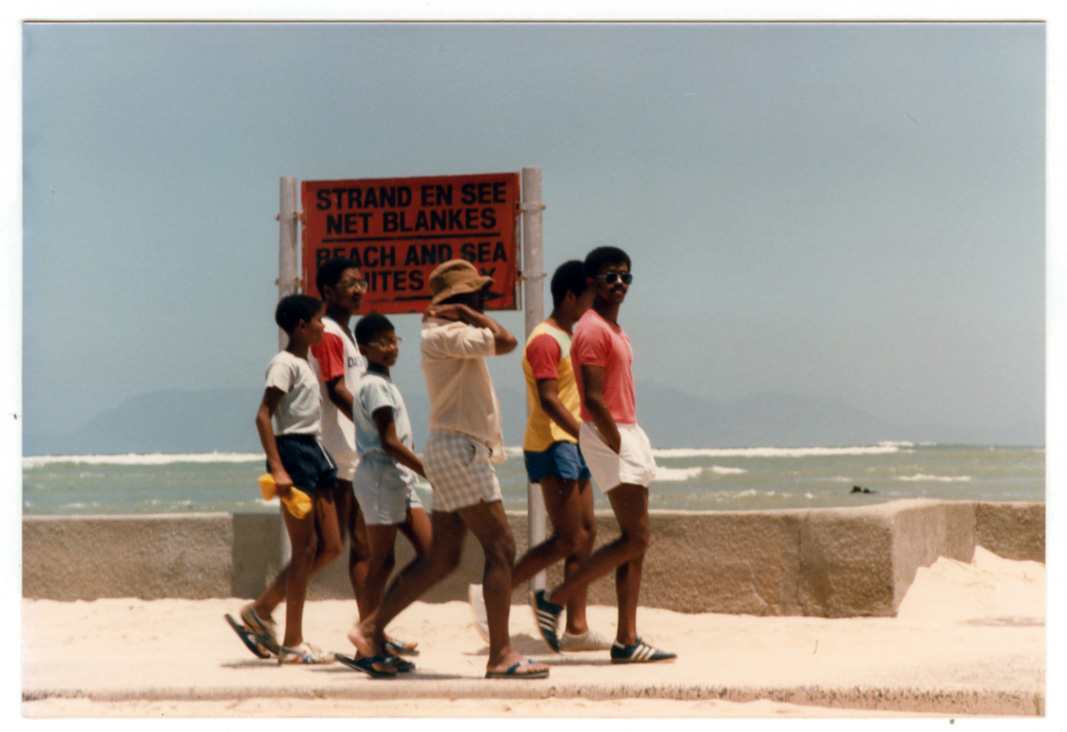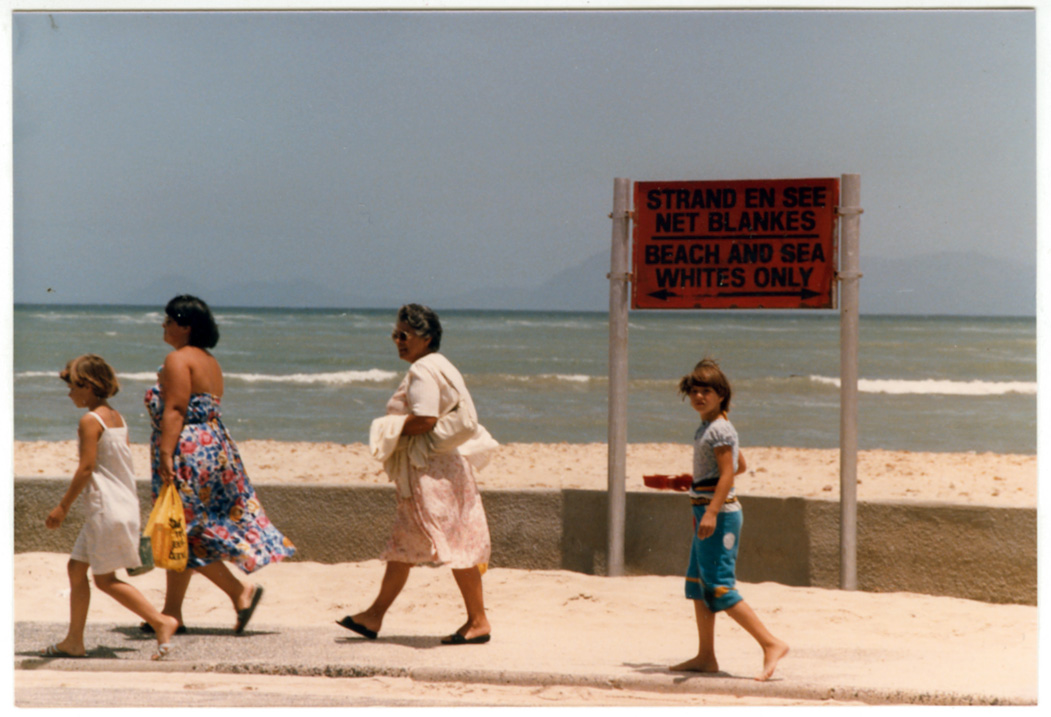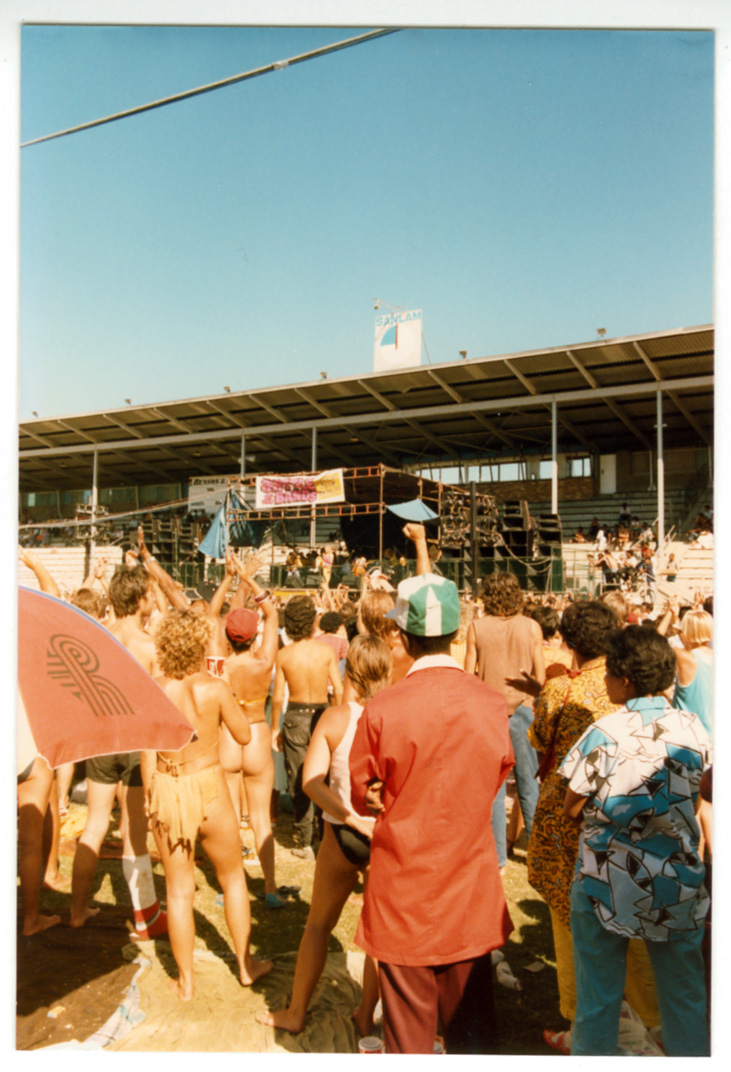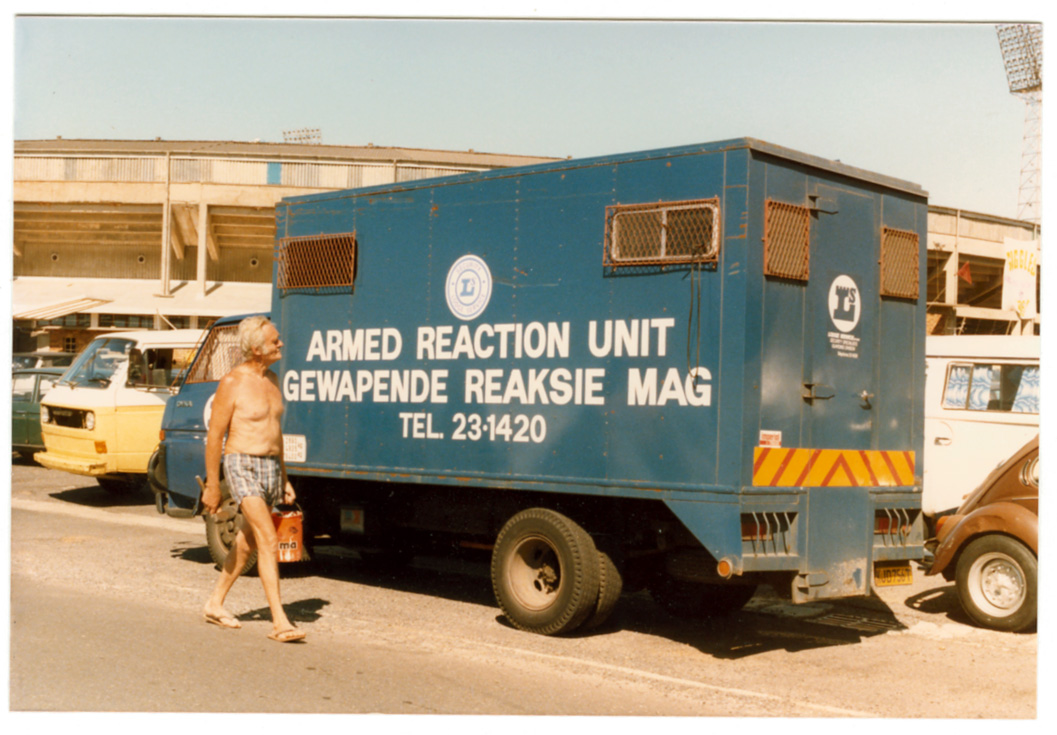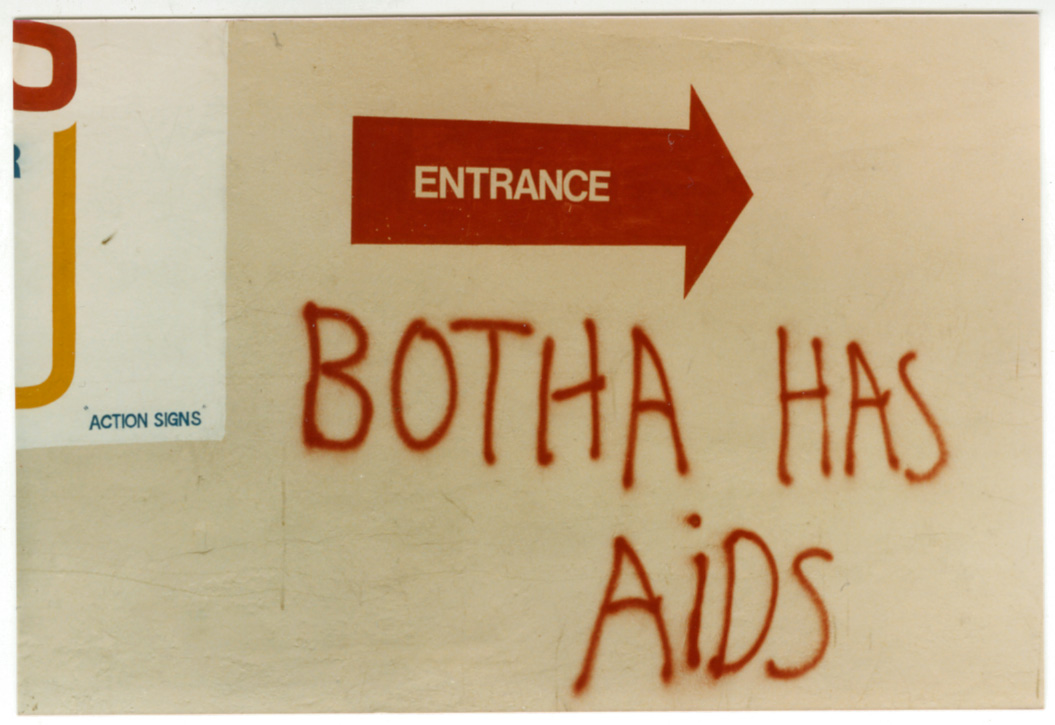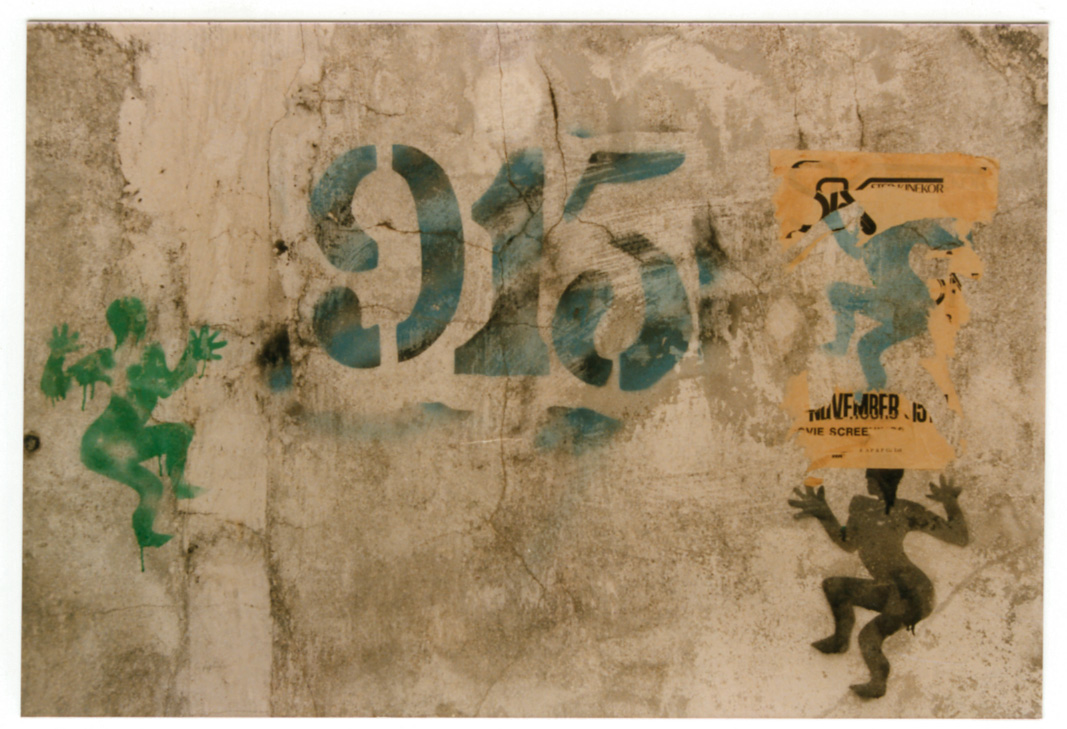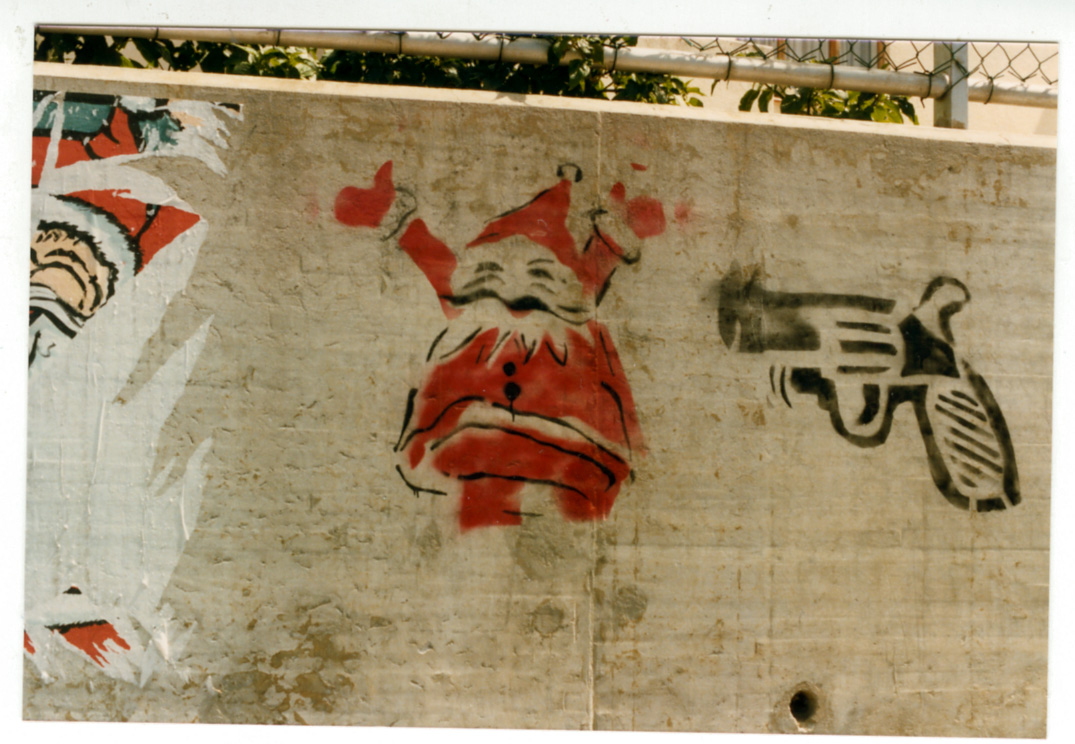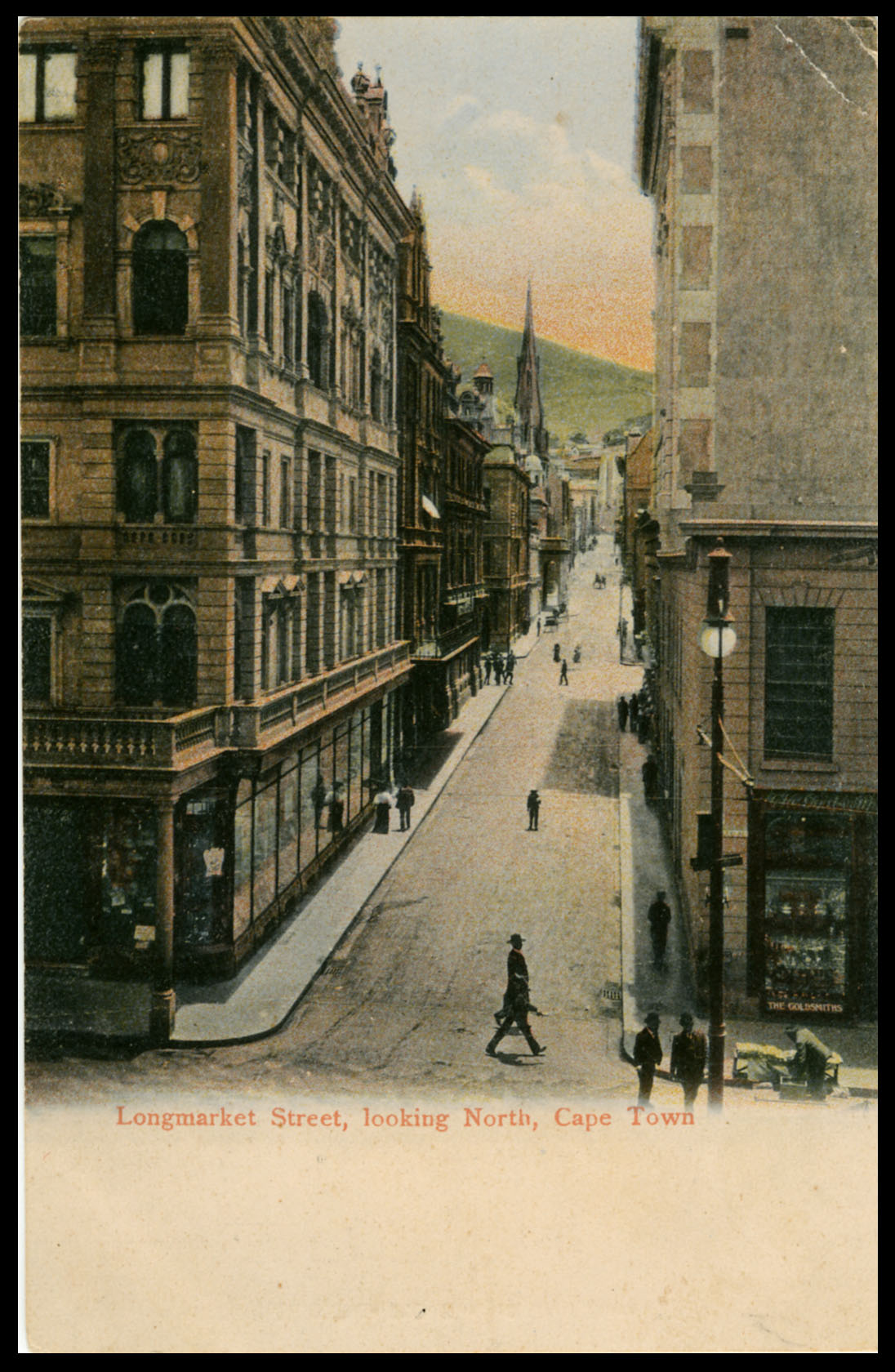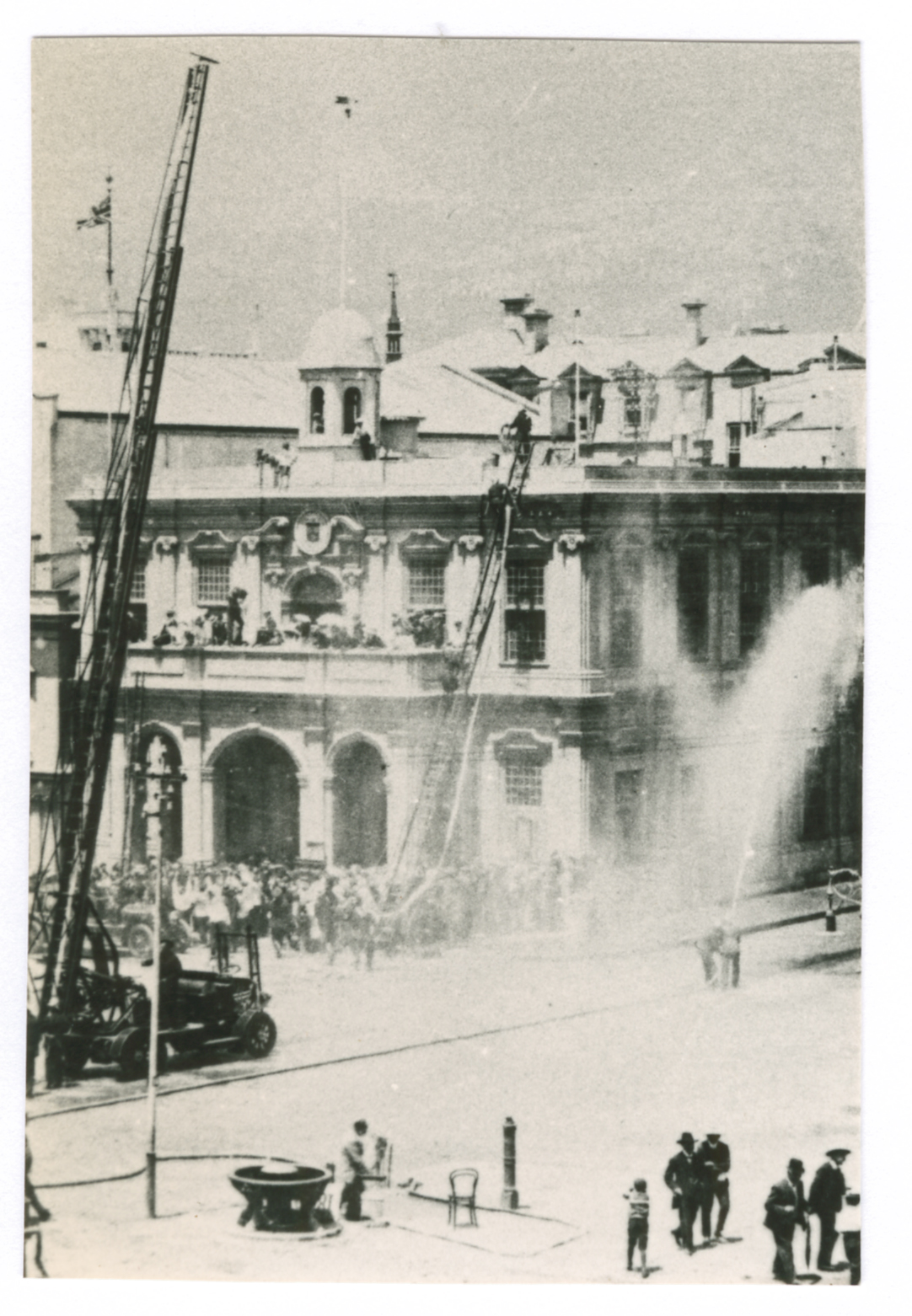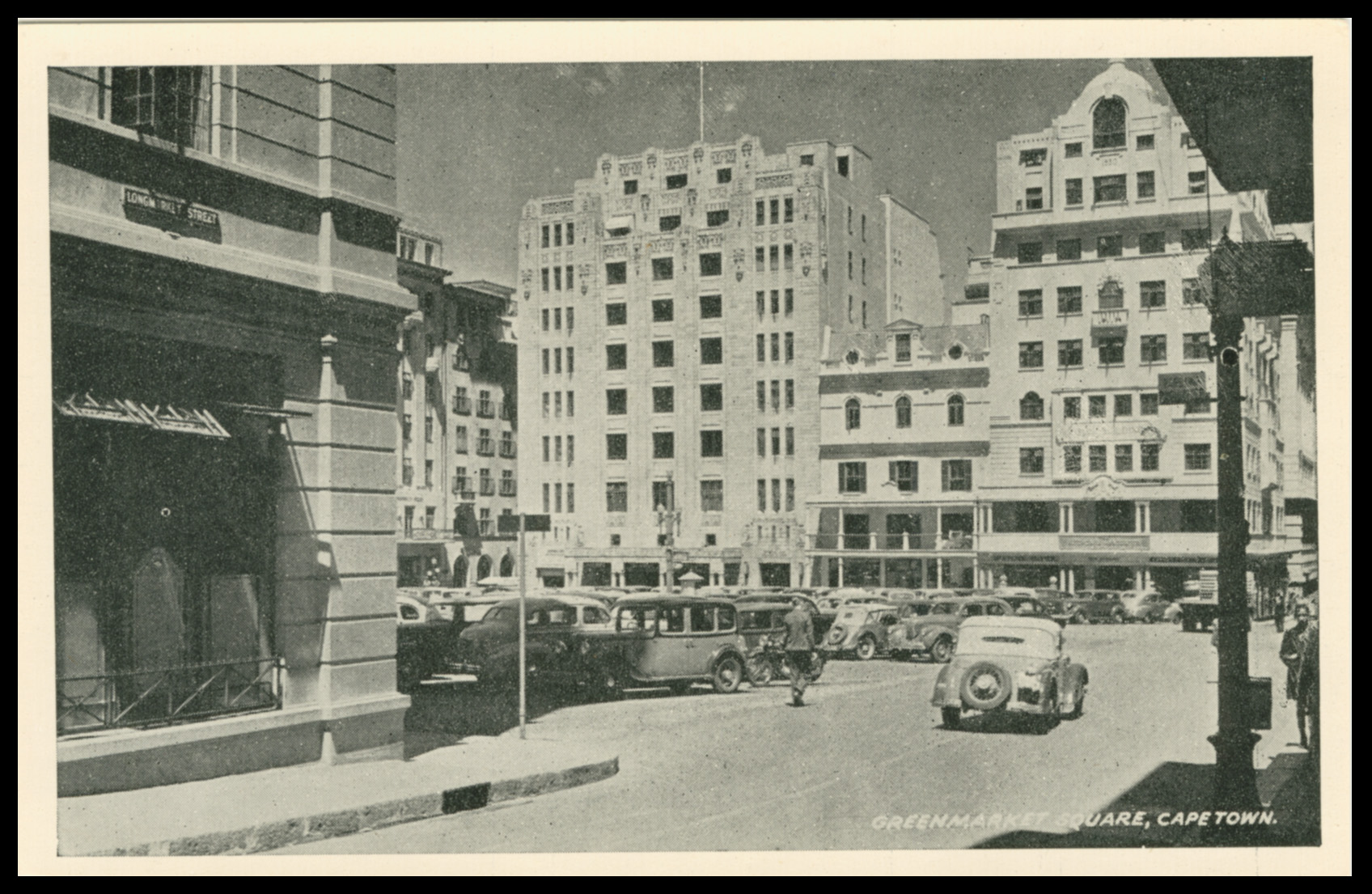GREENMARKET SQUARE, CAPE TOWN
Quote from Steve on April 21, 2022, 10:56 amI am a great fan of Greenmarket Square and visit it every time I go to Cape Town. As a boy growing up in Cape Town, then a eurocentric colonial era town, my earliest memory of Greenmarket Square was as a cobbled car park. Apparently, Greenmarket Square's decline started in 1905 when City Hall was built and its activities transferred to the Grand Parade. Today the natural order of things is restored with the Parade now a car park and Greenmarket Square the throbbing street market 'city hall' heart of Cape Town.
Greenmarket Square was first established in 1696, some 44 years after the Dutch arrived. It received its name, presumably, from its first use as a market square where fresh vegetables grown in the nearby Company’s Garden were sold. Slaves were also sold here, though that was not uncommon around Cape Town. There are half-a-dozen sites within the center of town where slaves were sold, the most notorious being the Old Slave Tree (now gone) in Church Square pretty much right outside the door of the Dutch Reformed Groote Kerk (a proximity that provides a clue to why segregation and Apartheid was succoured by the Church over thre centuries!)
What I like most about Greenmarket Square is mix of old and new - the Dutch era Town House, the home of the Michaelis Collection of art, the glorious art deco buildings and the colourful African buzz among the market stalls. It has always represented the best of Cape Town in transition. By the 1980s the Square had become a flea market for counter-cultural, gay and or elderly Whites selling bric-a brac and clutter that with the collapse of Apartheid was soon taken over - liberated - by multi-cultural African traders selling much the same ethnic goods to tourists. I witnessed the transition, even took some photos. See next post below. (Coming Soon).
But back to Greenmarket Square. I always found it a wonderful meeting place. I recall meeting a journalist from New Zealand who said that based on his two weeks in SA that we, the country, was hell-bent on a genocidal holocaust. He said that he had met no anti-Apartheid Whites in his two weeks in SA, that I was the first White to express any liberal pro-democratic opinions. I scoffed at that remark and told him to go and talk to the people on the Square. It was the heart of my beloved liberal Cape Town, after all. Despite everything, good and bad, Greenmarket Square retains its wonderful optimism. I wish I could be there to see it in a 100 years time!
The first two images are from 'OUR SOUTH AFRICA'. (I guess its author, C. Graham Botha, a Cape Archives pal of the faker A. A. Jurgens RDPSA FRPSL, never intended it to include Black South Africans.) The third and fourth PCs are self-explannatory and show the Old Watch House / Town House that is now the Iziko Michaelis Collection Art Gallery. The last B/W PC I found and updated after I wrote the preceding. Interestingly, to the left of the Town House is the low, no-thatch 'Old Thatched Tavern'. In the 1970s I dug up a pumpkin seed bottle in the Bellville dump that was embossed with the name of this pub. It is shown in Al Lastivico's book on SA Bottles , I think.
I am a great fan of Greenmarket Square and visit it every time I go to Cape Town. As a boy growing up in Cape Town, then a eurocentric colonial era town, my earliest memory of Greenmarket Square was as a cobbled car park. Apparently, Greenmarket Square's decline started in 1905 when City Hall was built and its activities transferred to the Grand Parade. Today the natural order of things is restored with the Parade now a car park and Greenmarket Square the throbbing street market 'city hall' heart of Cape Town.
Greenmarket Square was first established in 1696, some 44 years after the Dutch arrived. It received its name, presumably, from its first use as a market square where fresh vegetables grown in the nearby Company’s Garden were sold. Slaves were also sold here, though that was not uncommon around Cape Town. There are half-a-dozen sites within the center of town where slaves were sold, the most notorious being the Old Slave Tree (now gone) in Church Square pretty much right outside the door of the Dutch Reformed Groote Kerk (a proximity that provides a clue to why segregation and Apartheid was succoured by the Church over thre centuries!)
What I like most about Greenmarket Square is mix of old and new - the Dutch era Town House, the home of the Michaelis Collection of art, the glorious art deco buildings and the colourful African buzz among the market stalls. It has always represented the best of Cape Town in transition. By the 1980s the Square had become a flea market for counter-cultural, gay and or elderly Whites selling bric-a brac and clutter that with the collapse of Apartheid was soon taken over - liberated - by multi-cultural African traders selling much the same ethnic goods to tourists. I witnessed the transition, even took some photos. See next post below. (Coming Soon).
But back to Greenmarket Square. I always found it a wonderful meeting place. I recall meeting a journalist from New Zealand who said that based on his two weeks in SA that we, the country, was hell-bent on a genocidal holocaust. He said that he had met no anti-Apartheid Whites in his two weeks in SA, that I was the first White to express any liberal pro-democratic opinions. I scoffed at that remark and told him to go and talk to the people on the Square. It was the heart of my beloved liberal Cape Town, after all. Despite everything, good and bad, Greenmarket Square retains its wonderful optimism. I wish I could be there to see it in a 100 years time!
The first two images are from 'OUR SOUTH AFRICA'. (I guess its author, C. Graham Botha, a Cape Archives pal of the faker A. A. Jurgens RDPSA FRPSL, never intended it to include Black South Africans.) The third and fourth PCs are self-explannatory and show the Old Watch House / Town House that is now the Iziko Michaelis Collection Art Gallery. The last B/W PC I found and updated after I wrote the preceding. Interestingly, to the left of the Town House is the low, no-thatch 'Old Thatched Tavern'. In the 1970s I dug up a pumpkin seed bottle in the Bellville dump that was embossed with the name of this pub. It is shown in Al Lastivico's book on SA Bottles , I think.
Uploaded files:Quote from Steve on April 21, 2022, 12:46 pmHere are a few pretty poor photos showing aspects of Cape Town in the mid-to-late 1980s. They do, I hope, provide some sense of the time and what was happening around town and beyond. Further to this thread, I start with some images of Greenmarket Square. In the second photo you can see the Methodist Church in the postcard above.
The downside of this Wordpress Forum add-on is that it only allows five images per post. So, I will perforce have to add others below this. This will include the African musicians and dancers who were first to colonise Cape Town's inner city centre, some 'cheeky Cape Coloured' carousing, some unarmed SADF conscripts looking on curiously, a posh Greenmarket Square coffee shop under siege from the homeless, a multi-racial Battle of the Bands at Green Point Stadium with buttocks - White girls going Native! Oooh-weee! Fear and loathing in Triomf! I recall a pop festival here in the 70's where White kids tore down the fences separating them from Blacks, not something that is common knowledge today. And finally a few images of a segregated beach, the Strand, I think.
Okay, so this is not Philately but it is History.
Here are a few pretty poor photos showing aspects of Cape Town in the mid-to-late 1980s. They do, I hope, provide some sense of the time and what was happening around town and beyond. Further to this thread, I start with some images of Greenmarket Square. In the second photo you can see the Methodist Church in the postcard above.
The downside of this Wordpress Forum add-on is that it only allows five images per post. So, I will perforce have to add others below this. This will include the African musicians and dancers who were first to colonise Cape Town's inner city centre, some 'cheeky Cape Coloured' carousing, some unarmed SADF conscripts looking on curiously, a posh Greenmarket Square coffee shop under siege from the homeless, a multi-racial Battle of the Bands at Green Point Stadium with buttocks - White girls going Native! Oooh-weee! Fear and loathing in Triomf! I recall a pop festival here in the 70's where White kids tore down the fences separating them from Blacks, not something that is common knowledge today. And finally a few images of a segregated beach, the Strand, I think.
Okay, so this is not Philately but it is History.
Uploaded files:Quote from Steve on April 21, 2022, 1:17 pmSome carousing. "Lag, lag elke dag" (Afr. laugh, laugh every day) because if you can't you will surely cry!
The second photo shows a habitue of the inner city centre, a relatively cool and benign guy I knew only as 'Hendrix'. The story went around that Jarman Street 'hippies' had given Hendrix a cap of acid (LSD). I am not certain about the truth of that but it was widely believed at the time given his slow drain-bamaged demeanour.
Finally, the remaining photos show the Siege of the Coffee Shop on Greenmarket Square. A recent South African impossibility, a multi-racial duo, play a little brunch-time music for the eating classes on the 'stoep' (Afr. porch) of the hotel. Some spontaneous F.U. dancing breaks out and soon there is insurrection Cape Town-style. The only confrontational thing about it was the dancer's being told to "Go dance somewhere else! Not in my coffee shop" I feel sorry for the Security Guard! It amazes me that the resistance of these dispossesed people to White privilege was to celebrate life by laughing and dancing to a chant of "kan 'n man dan nie" (Afr. can a person not do this?). I love the last photo showing two uptight White men, the blonde one the Coffee Shop manager, the sour other a seated customer. The third White man wearily hides behind an expression that says this is all too tedious and beneath him.
Some carousing. "Lag, lag elke dag" (Afr. laugh, laugh every day) because if you can't you will surely cry!
The second photo shows a habitue of the inner city centre, a relatively cool and benign guy I knew only as 'Hendrix'. The story went around that Jarman Street 'hippies' had given Hendrix a cap of acid (LSD). I am not certain about the truth of that but it was widely believed at the time given his slow drain-bamaged demeanour.
Finally, the remaining photos show the Siege of the Coffee Shop on Greenmarket Square. A recent South African impossibility, a multi-racial duo, play a little brunch-time music for the eating classes on the 'stoep' (Afr. porch) of the hotel. Some spontaneous F.U. dancing breaks out and soon there is insurrection Cape Town-style. The only confrontational thing about it was the dancer's being told to "Go dance somewhere else! Not in my coffee shop" I feel sorry for the Security Guard! It amazes me that the resistance of these dispossesed people to White privilege was to celebrate life by laughing and dancing to a chant of "kan 'n man dan nie" (Afr. can a person not do this?). I love the last photo showing two uptight White men, the blonde one the Coffee Shop manager, the sour other a seated customer. The third White man wearily hides behind an expression that says this is all too tedious and beneath him.
Uploaded files:Quote from Steve on April 22, 2022, 10:44 amI took these photos when I was living at the top of Breda Street in a lovely colonial villa. (Those were the days!).
The first photo shows Hendrix during the Siege of the Coffee Shop on Greenmarket Square. He looks angry but I never knew him like that. That's Julie on the left under the mass of red hair. The woman centre is the mother of the child. The last time I saw Julie was in April 1994 outside SA House in London when South Africans queued around the block to vote in our country's first democratic elections. Did Hendrix influence our votes? The second photo shows a voteless man sleeping in a cardboard box on Greenmarket Square at noon. I wish I could believe he is 'all partied-out' Cape-style.
The third photo was taken in Bo-Kaap where I would park my car before walking into town and visiting the Computer Shops in Long Street, (Tony Meechin's 'Silicon Alley'), then down into Greenmarket Square. Perhaps this 'Burn Baby Burn' image is the future that Hendrix is predicting. Has it come to pass? I am not so sure. Cape Town remains more of a 'Disco Inferno' than a wasteland of retribution. The fourth and fifth photos are taken at the Strand, near Gordon's Bay, close to the 'Wild West', Somerset West. By this time petty Beach Apartheid was largely being ignored.
I took these photos when I was living at the top of Breda Street in a lovely colonial villa. (Those were the days!).
The first photo shows Hendrix during the Siege of the Coffee Shop on Greenmarket Square. He looks angry but I never knew him like that. That's Julie on the left under the mass of red hair. The woman centre is the mother of the child. The last time I saw Julie was in April 1994 outside SA House in London when South Africans queued around the block to vote in our country's first democratic elections. Did Hendrix influence our votes? The second photo shows a voteless man sleeping in a cardboard box on Greenmarket Square at noon. I wish I could believe he is 'all partied-out' Cape-style.
The third photo was taken in Bo-Kaap where I would park my car before walking into town and visiting the Computer Shops in Long Street, (Tony Meechin's 'Silicon Alley'), then down into Greenmarket Square. Perhaps this 'Burn Baby Burn' image is the future that Hendrix is predicting. Has it come to pass? I am not so sure. Cape Town remains more of a 'Disco Inferno' than a wasteland of retribution. The fourth and fifth photos are taken at the Strand, near Gordon's Bay, close to the 'Wild West', Somerset West. By this time petty Beach Apartheid was largely being ignored.
Uploaded files:Quote from Steve on April 22, 2022, 12:29 pmOkay, last leg and nothing here on Greenmarket Square. All from the same roll of film! Remember 35mm film?
The first image shows the Battle of the Bands in the old Green Point Stadium. This would appear to have ben a multi-racial event but why Blacks would want to go to hear Anglo-Saxon rock 'n roll makes no sense. No wonder the young man's arms are crossed. Boring! Perhaps the moment's saving grace is the sight of White girls 'going Native'. Outside the stadium lies a back-up plan, an 'Armed Response Unit' just in case a riot breaks out rather than the anticipated love-in. The topless pot-bellied old White boy poodling past in his slip-slops and shorts is so Capey Town!
The remaining items are just bits of grafitti that I saw. Regarding "Botha has AIDS", I was told by Africans sceptical of the USA's good intentions that AIDS stood for 'American Imperialist Death Strategy'. Botha was known to his fellow Nationalists as 'Die Groot Krokodil' (Afr. the Great Crocodile). AIDS was originally believed to have passed down from chimpanzees to humans. Given Botha's black deeds, you can be forgiven for thinking that AIDS passed down from the 'Groot Krokodil' himself. The bottom-line is that Botha was a mass murderer who was allowed to get away with crimes against humanity for the sake of national reconciliation, something he defied until he died!
The lizard-like dancers are weird and wonderful, like geckos on the wall. But geckos almost never shake, shake, shake! Finally, Santa, held up at gun-point over Christmas. Is Apartheid and Capitalism stealing the artist's pressies?
Okay, last leg and nothing here on Greenmarket Square. All from the same roll of film! Remember 35mm film?
The first image shows the Battle of the Bands in the old Green Point Stadium. This would appear to have ben a multi-racial event but why Blacks would want to go to hear Anglo-Saxon rock 'n roll makes no sense. No wonder the young man's arms are crossed. Boring! Perhaps the moment's saving grace is the sight of White girls 'going Native'. Outside the stadium lies a back-up plan, an 'Armed Response Unit' just in case a riot breaks out rather than the anticipated love-in. The topless pot-bellied old White boy poodling past in his slip-slops and shorts is so Capey Town!
The remaining items are just bits of grafitti that I saw. Regarding "Botha has AIDS", I was told by Africans sceptical of the USA's good intentions that AIDS stood for 'American Imperialist Death Strategy'. Botha was known to his fellow Nationalists as 'Die Groot Krokodil' (Afr. the Great Crocodile). AIDS was originally believed to have passed down from chimpanzees to humans. Given Botha's black deeds, you can be forgiven for thinking that AIDS passed down from the 'Groot Krokodil' himself. The bottom-line is that Botha was a mass murderer who was allowed to get away with crimes against humanity for the sake of national reconciliation, something he defied until he died!
The lizard-like dancers are weird and wonderful, like geckos on the wall. But geckos almost never shake, shake, shake! Finally, Santa, held up at gun-point over Christmas. Is Apartheid and Capitalism stealing the artist's pressies?
Uploaded files:Quote from Steve on May 28, 2022, 10:37 amFinally, back to the beginning in a faraway euro-centric century in another millenium in another country.
Here is a postcard looking up Longmarket Street towards Signal Hill. You can see the spire of the Methodist Church on the top left of Longmarket Street, indicating where Greenmarket Square is to its right. Longmarket Street runs down the western side of Greenmarket Square while Shortmarket Street, out of view, runs parallel down the eastern side. This view is presumably across Adderley Street. The general dealer, jeweller and goldsmith, Emil Burmester, one of the great benefactors of Cape postal history, had a shop nearby at 78 Adderley Street about this time. I bought this postcard hoping that one of the two shops was his. Sadly, however, he did not have a corner shop.
Finally, back to the beginning in a faraway euro-centric century in another millenium in another country.
Here is a postcard looking up Longmarket Street towards Signal Hill. You can see the spire of the Methodist Church on the top left of Longmarket Street, indicating where Greenmarket Square is to its right. Longmarket Street runs down the western side of Greenmarket Square while Shortmarket Street, out of view, runs parallel down the eastern side. This view is presumably across Adderley Street. The general dealer, jeweller and goldsmith, Emil Burmester, one of the great benefactors of Cape postal history, had a shop nearby at 78 Adderley Street about this time. I bought this postcard hoping that one of the two shops was his. Sadly, however, he did not have a corner shop.
Uploaded files:Quote from Steve on July 10, 2022, 10:28 am.... and finally back to Greenmarket Square. Here is a photograph from the Robert Hill Collection, 'The Old Town House on Greenmarket Square, has a Fire Drill'. This is the same photograph Ralph Putzel used in his Encyclopedia, (page 324, Vol. 1). Putzel does not date this but my guess is that it is the very late 1920s, very early 1930s. It certainly seems an authentic drill!
.... and finally back to Greenmarket Square. Here is a photograph from the Robert Hill Collection, 'The Old Town House on Greenmarket Square, has a Fire Drill'. This is the same photograph Ralph Putzel used in his Encyclopedia, (page 324, Vol. 1). Putzel does not date this but my guess is that it is the very late 1920s, very early 1930s. It certainly seems an authentic drill!
Uploaded files:Quote from Steve on January 10, 2024, 4:10 pmEighteen months later.... apparently. How time flies!
I recently bought two postcards of Greenmarket Square. I had some difficulty identifying the direction of view.
Both show a letterbox more-or-less in the centre of the square, just off Burg Street that divides Greenmarket Square in two. I vaguely recall one being there in the 1980s but is it still there today?
The first view is looking east towards Adderley Street, the Railway Station and the hinterland. What threw me is the dark roof centre right that I mistook for the slope of Signal Hill. It probably belongs to one of the tall buildings in St George's Street. The photographer is standing with his back to the Methodist Church, completed in 1879, the year of ..... the piratical British invasion of Zululand.
The second view (above) is looking south towards Table Mountain, Simonstown and Patagonia. The building on the left has a sign on the roof that says 'The Argus Coy'. The combination of this postcard with my Argus newspaper wrapper with Argus Wheel datestamp will make a very attractive display item. Oh, what the heck.... It's off piste, I know, but let me share it with you here!
Deltiology (the collecting of postcards) and Postal History are forms of Archaeology that don't require digging but which equally bring the recent Past to Life! (In the 1970s I dug up a pumpkin seed bottle in the Bellville colonial rubbish dump aka to us 'bottle diggers' as 'the tip'. It was embossed with 'Ye Old Thatched Tavern'. I sold it to the Lastivicos who used it to illustrate their book on SA Bottles. How I would like to own it now! Maybe I will post a scan of it here one day. I think his books also shows a magnficent but chipped cobalt blue ink bottle that I found and sold to him. I wonder if any letter written with the ink from that bottle has graced these posts?)
Oh dear, here I go down the slippery slope once more, dear friends.... I will have to write up my days as a 'digger'.
If any are interested, I dug up examples of pretty much all or similar of the items shown here. The two bottles with labels would not have been dig up by the Lastivicos. They would have acquired them by other means. Two 'tooth paste lids' are shown. We always valued these. The marble (Codd) bottle, right, was a common find (but never with a label). We found hundreds of round, pointed bottom Hamiltons, not shown, which we threw away, calling then 'vermin'. Today they are almost 'classic'.
Our most sought after bottle was the Dutch gin, the dark green 'coffin' bottle, second right. The Lastivico's example is a fairly ordinary one without the seal on the shoulder. When we plundered the site of what we believed was the oldest British Army camp in SA on Rondebosch Common, we found three massive Dutch gins intact, each with a flat, button top as shown and with large 'Pollen & Zoon' seals. (We also found broken swords, bits of pistols and about two feet of gold chain thrown out with the rubbish.) I have seen similar Dutch gins sell at auction for 1000s of dollars. They are so scarce few Amsterdam dealers can offer them to you.
The P. Sullivan earthenware is common. It is from 'Kimberley', actually Beaconsfield, and shows what we always assumed was not P. Sullivan but C. J. Rhodes. Say no more lest someone smash this historic artefact in a fit of disgust.
The reason the 'Bellville tip' was called a tip was because Cape Town's rubbish, (this is what the above was), would be collected and taken to a railway siding where it would dumped into special wagons or bins. These would be railed to the area of the Cape Flats that stands behind Cape Town International Airport today, more-or-less where Belhar is. We knew the area as the 'Bellville' tip. We gave different names to parts of it, like the Shooting Range, the Stink Vlei and, of course, the Tip itself, about hundred yards long . This was where the contents of the wagons were dumped in the bush and vleis by tipping them over on their sides. The tip's railway was excavated on one side to create a drop. It was here that a good 20-30 feet of dump accumulated. Most people didn't have the enthusiasm to dig that deep. We did! My good friend Jimmy MacDonald had a narrow eascape digging up a huge coffin bottle when the bank collapsed on him, trapping him waist deep in soil and broken bottles. Ja, Jimmy Mac led a charmed life! The ladies loved him.
The first people in Cape Town to collect bottles in the 1960s simply walked through the bush, picking up items off the ground. Later people began to scratch the surface, then dig for bottles in a random, haphazard way. In order to reach the untouched oldest good stuff that had been the first to be tipped we had a hard job in the early 1970s digging through ground that had been partially dug up and covered over gain. The goal was always to find virgin dump. It was dangerous work and fun, what with cave-ins and snakes, scorpions and spiders falling into our holes occassionally. There were stil buck in the bush. We all suffered the occassional bad cut from the broken glass but we soldiered on. We felt like old-time prospectors and pioneers. It was time of great personal freedom! It all came to an end in 1976.
Below are the only two bottles I still have in my possession. Sometimes I like to pass these around when I am giving a display. Some of the older philatelists remember them, even breaking them to get the marble out. The marble bottle left has a nice embossed lion and is from 'Goldberg & Zeffer, Johannesburg and Boksburg'. The tall green one is you typical turn-of-the-century SAB (South African Breweries) beer bottle which is found all over SA. 'Ten green bottles....' See cover of Bottles & Bygones. It is nothing to shout about unlike the marble bottle which is a conversation piece, a curious Victorian invention. They were manuafcturesd all over the world, some into the 1950s. They were popular in Japan and often appear in period Studio Ghibli animations lying in ponds and or under houses.
Eighteen months later.... apparently. How time flies!
I recently bought two postcards of Greenmarket Square. I had some difficulty identifying the direction of view.
Both show a letterbox more-or-less in the centre of the square, just off Burg Street that divides Greenmarket Square in two. I vaguely recall one being there in the 1980s but is it still there today?
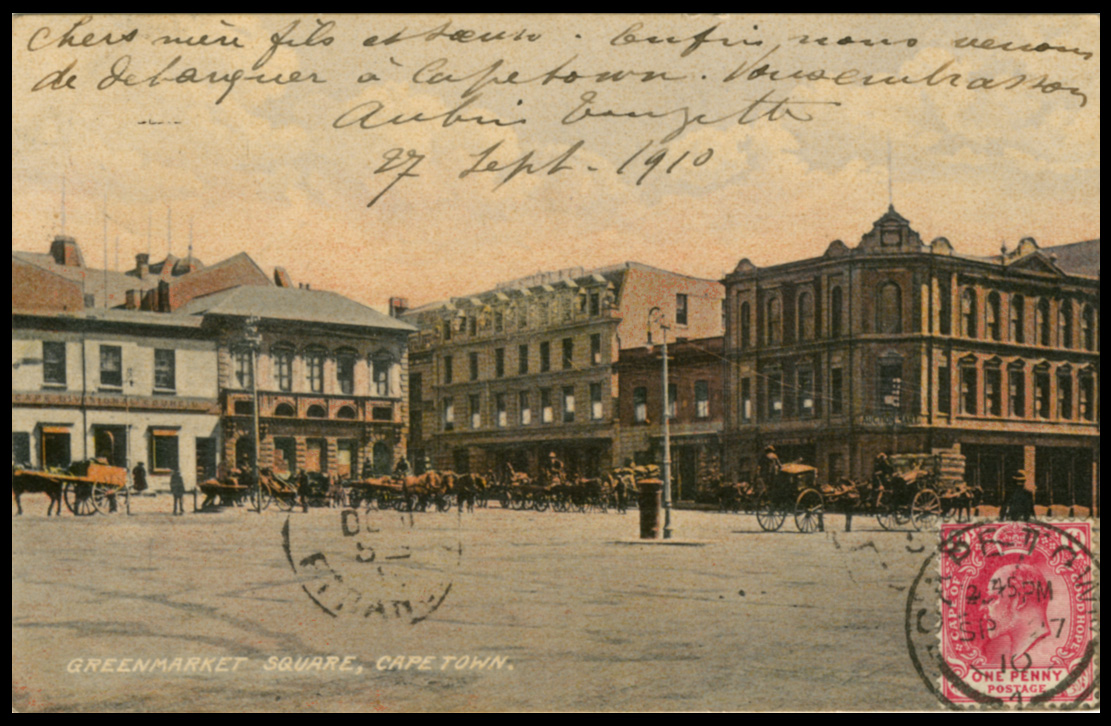
The first view is looking east towards Adderley Street, the Railway Station and the hinterland. What threw me is the dark roof centre right that I mistook for the slope of Signal Hill. It probably belongs to one of the tall buildings in St George's Street. The photographer is standing with his back to the Methodist Church, completed in 1879, the year of ..... the piratical British invasion of Zululand.
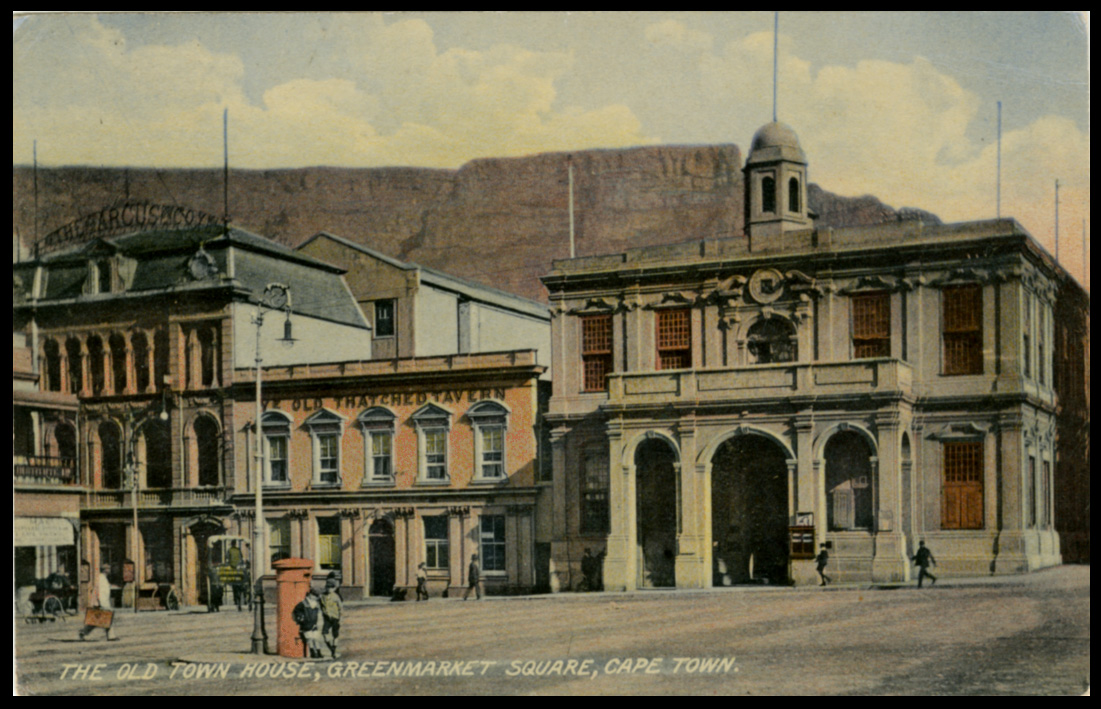
The second view (above) is looking south towards Table Mountain, Simonstown and Patagonia. The building on the left has a sign on the roof that says 'The Argus Coy'. The combination of this postcard with my Argus newspaper wrapper with Argus Wheel datestamp will make a very attractive display item. Oh, what the heck.... It's off piste, I know, but let me share it with you here!
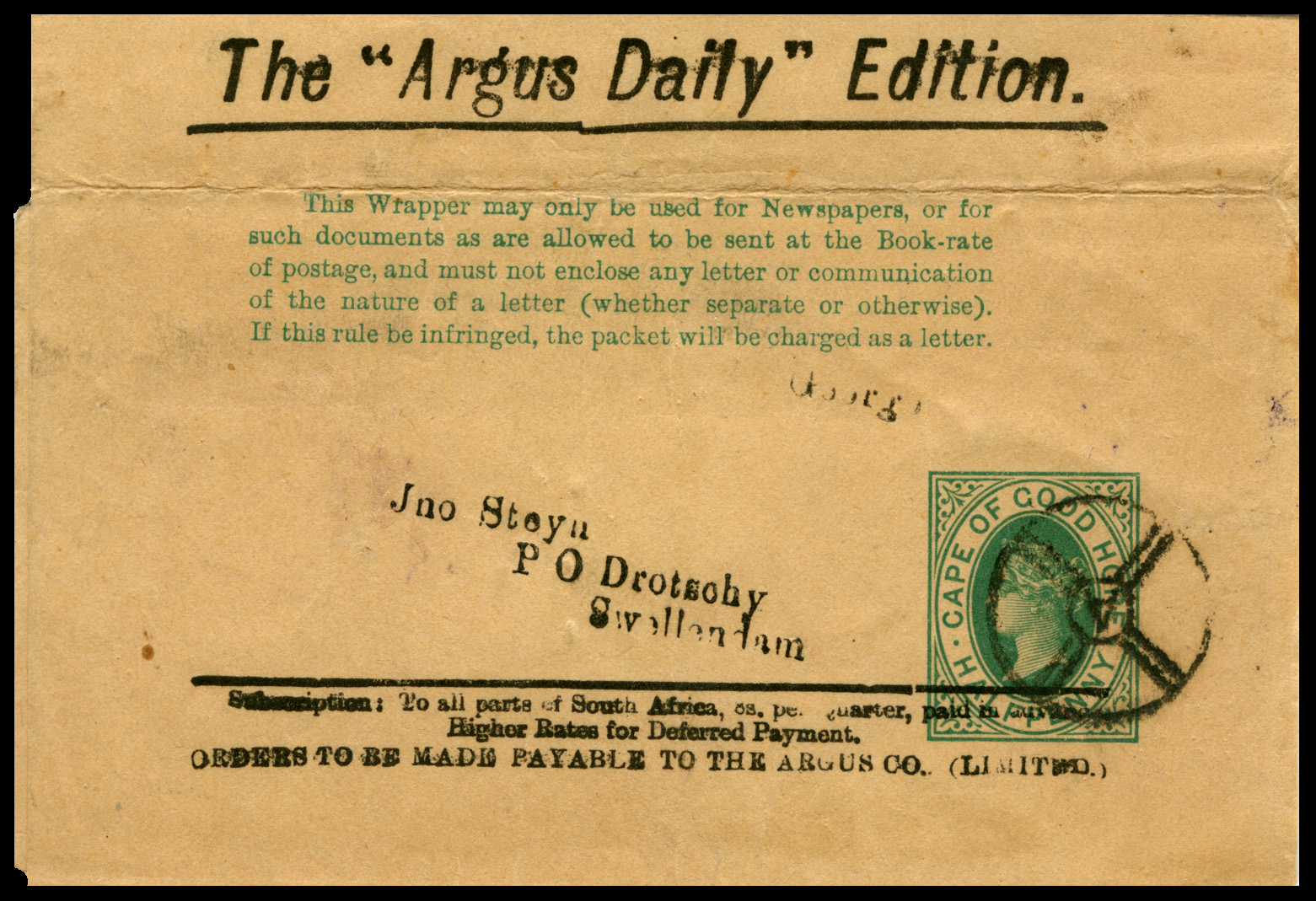
Deltiology (the collecting of postcards) and Postal History are forms of Archaeology that don't require digging but which equally bring the recent Past to Life! (In the 1970s I dug up a pumpkin seed bottle in the Bellville colonial rubbish dump aka to us 'bottle diggers' as 'the tip'. It was embossed with 'Ye Old Thatched Tavern'. I sold it to the Lastivicos who used it to illustrate their book on SA Bottles. How I would like to own it now! Maybe I will post a scan of it here one day. I think his books also shows a magnficent but chipped cobalt blue ink bottle that I found and sold to him. I wonder if any letter written with the ink from that bottle has graced these posts?)
Oh dear, here I go down the slippery slope once more, dear friends.... I will have to write up my days as a 'digger'.
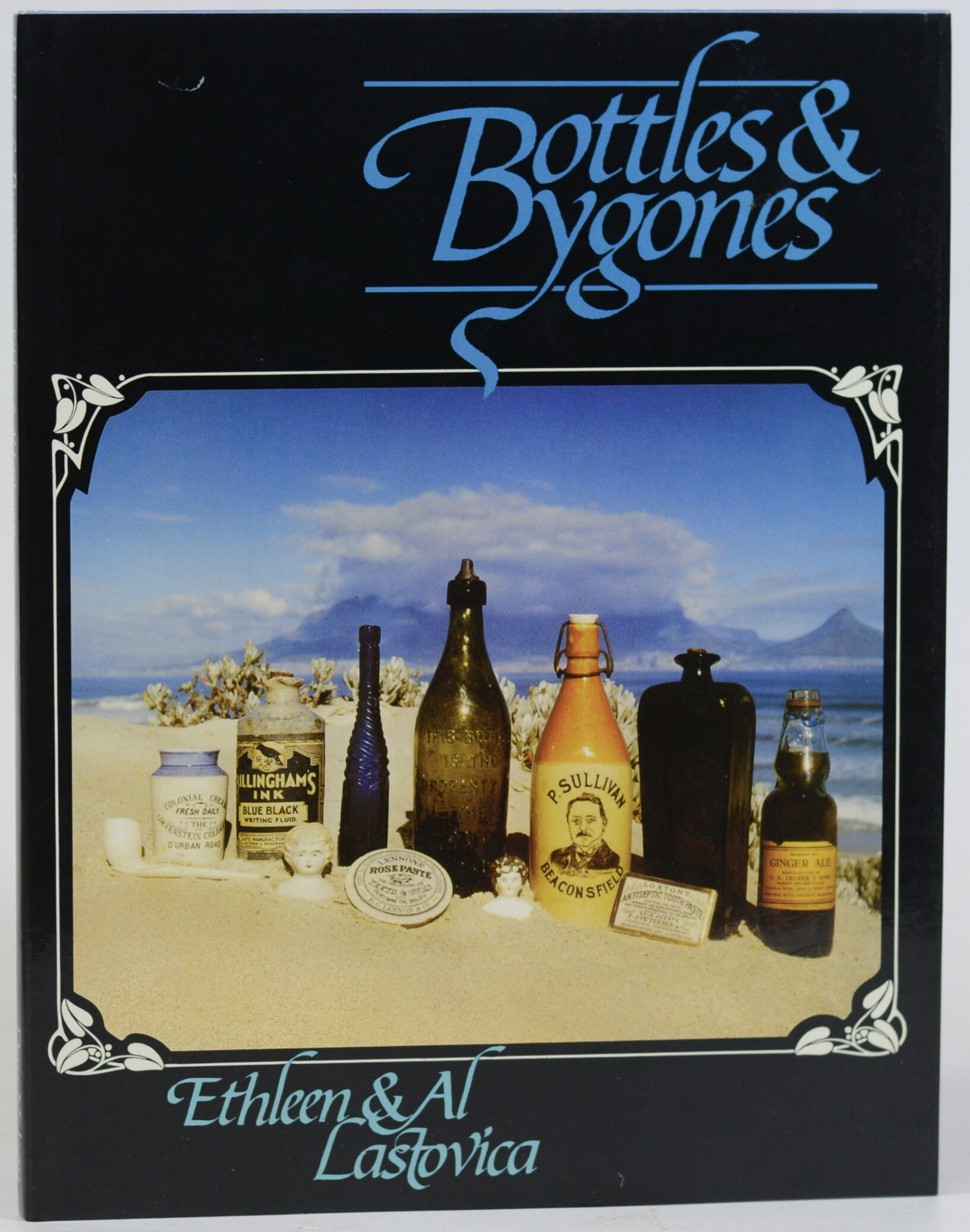
If any are interested, I dug up examples of pretty much all or similar of the items shown here. The two bottles with labels would not have been dig up by the Lastivicos. They would have acquired them by other means. Two 'tooth paste lids' are shown. We always valued these. The marble (Codd) bottle, right, was a common find (but never with a label). We found hundreds of round, pointed bottom Hamiltons, not shown, which we threw away, calling then 'vermin'. Today they are almost 'classic'.
Our most sought after bottle was the Dutch gin, the dark green 'coffin' bottle, second right. The Lastivico's example is a fairly ordinary one without the seal on the shoulder. When we plundered the site of what we believed was the oldest British Army camp in SA on Rondebosch Common, we found three massive Dutch gins intact, each with a flat, button top as shown and with large 'Pollen & Zoon' seals. (We also found broken swords, bits of pistols and about two feet of gold chain thrown out with the rubbish.) I have seen similar Dutch gins sell at auction for 1000s of dollars. They are so scarce few Amsterdam dealers can offer them to you.
The P. Sullivan earthenware is common. It is from 'Kimberley', actually Beaconsfield, and shows what we always assumed was not P. Sullivan but C. J. Rhodes. Say no more lest someone smash this historic artefact in a fit of disgust.
The reason the 'Bellville tip' was called a tip was because Cape Town's rubbish, (this is what the above was), would be collected and taken to a railway siding where it would dumped into special wagons or bins. These would be railed to the area of the Cape Flats that stands behind Cape Town International Airport today, more-or-less where Belhar is. We knew the area as the 'Bellville' tip. We gave different names to parts of it, like the Shooting Range, the Stink Vlei and, of course, the Tip itself, about hundred yards long . This was where the contents of the wagons were dumped in the bush and vleis by tipping them over on their sides. The tip's railway was excavated on one side to create a drop. It was here that a good 20-30 feet of dump accumulated. Most people didn't have the enthusiasm to dig that deep. We did! My good friend Jimmy MacDonald had a narrow eascape digging up a huge coffin bottle when the bank collapsed on him, trapping him waist deep in soil and broken bottles. Ja, Jimmy Mac led a charmed life! The ladies loved him.
The first people in Cape Town to collect bottles in the 1960s simply walked through the bush, picking up items off the ground. Later people began to scratch the surface, then dig for bottles in a random, haphazard way. In order to reach the untouched oldest good stuff that had been the first to be tipped we had a hard job in the early 1970s digging through ground that had been partially dug up and covered over gain. The goal was always to find virgin dump. It was dangerous work and fun, what with cave-ins and snakes, scorpions and spiders falling into our holes occassionally. There were stil buck in the bush. We all suffered the occassional bad cut from the broken glass but we soldiered on. We felt like old-time prospectors and pioneers. It was time of great personal freedom! It all came to an end in 1976.
Below are the only two bottles I still have in my possession. Sometimes I like to pass these around when I am giving a display. Some of the older philatelists remember them, even breaking them to get the marble out. The marble bottle left has a nice embossed lion and is from 'Goldberg & Zeffer, Johannesburg and Boksburg'. The tall green one is you typical turn-of-the-century SAB (South African Breweries) beer bottle which is found all over SA. 'Ten green bottles....' See cover of Bottles & Bygones. It is nothing to shout about unlike the marble bottle which is a conversation piece, a curious Victorian invention. They were manuafcturesd all over the world, some into the 1950s. They were popular in Japan and often appear in period Studio Ghibli animations lying in ponds and or under houses.
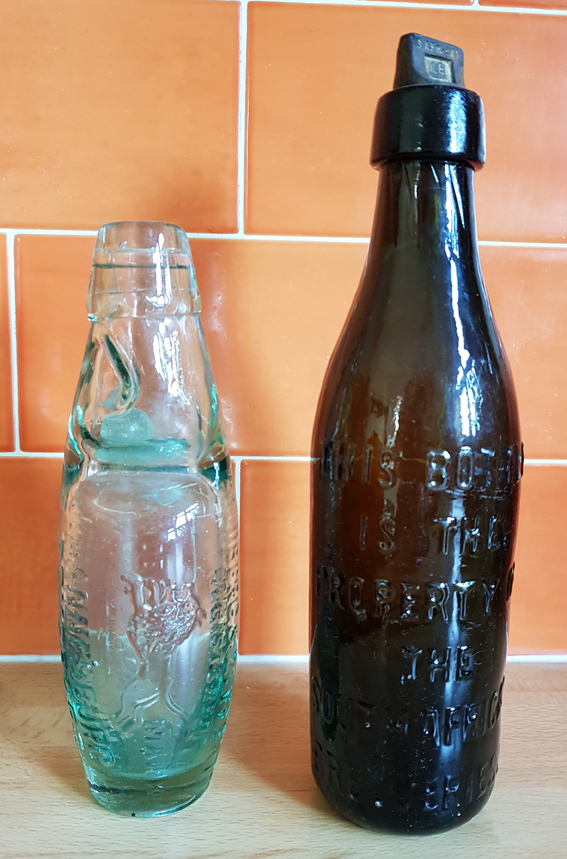
Quote from Steve on March 22, 2024, 4:58 pmWhen I was a boy in the 1950s both the Parade and Greenmarket Square were car parking lots. The postcard below is probably from about 1950. The view is from Long Market Street (see street sign) with St George's Street lying behind the facing buildings. This is the only street that runs the full width of the city bowl from Bo Kaap to District Six. The square developed during the Dutch VOC era as market for the sale of fresh produce from the Company garden and the surrounding farms, like Oranje Zicht, Roodebloem, etc., etc. The top of the previously mentioned letter box can be seen just above the roofs of the cars in the lower centre of the postcard. No trees can be seen.
When I was a boy in the 1950s both the Parade and Greenmarket Square were car parking lots. The postcard below is probably from about 1950. The view is from Long Market Street (see street sign) with St George's Street lying behind the facing buildings. This is the only street that runs the full width of the city bowl from Bo Kaap to District Six. The square developed during the Dutch VOC era as market for the sale of fresh produce from the Company garden and the surrounding farms, like Oranje Zicht, Roodebloem, etc., etc. The top of the previously mentioned letter box can be seen just above the roofs of the cars in the lower centre of the postcard. No trees can be seen.
Uploaded files:
